The Cherokee Nation Communications Department published a nice short piece on our work with the Medicine Keepers in the Spring / Summer 2020 issue of ᎠᎾᏗᏍᎪᎢ (Anadisgoi). Click here to view the article and photos. It’s on pages 15-16.
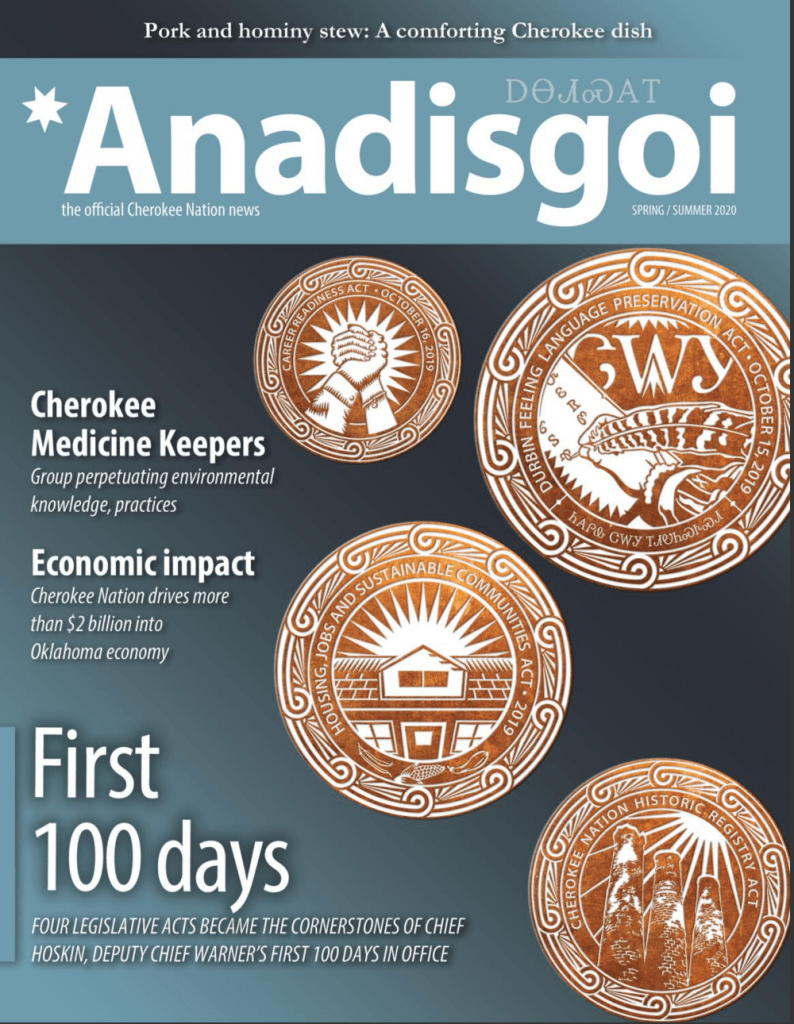
The Cherokee Nation Communications Department published a nice short piece on our work with the Medicine Keepers in the Spring / Summer 2020 issue of ᎠᎾᏗᏍᎪᎢ (Anadisgoi). Click here to view the article and photos. It’s on pages 15-16.


On a beautiful and clear day in October, students, staff, and Medicine Keepers gathered at our peaceful place of medicine, ᏅᏩᏙᎯᏯᏛ ᏅᏬᏘᎢ in Adair County. Our objective was for the elders to show us how to make ᎦᎾᏥ ganatsi from scratch. ᎦᎾᏥ ganatsi is a traditional Cherokee food made from ᏐᎯ hickory nuts that is typically eaten in the fall and winter. The process of making a ᎦᎾᏥ ᎠᏍᏆᏞᏍᏗ “ganatsi ball” is arduous and time-consuming, and involves the use of a large wooden mortar and pestle, called a ᎧᏃᎾ kanon and ᎠᏍᏙᏍᏙᏗ asdosdodi (or ᎠᏓᎶ adalo) in Cherokee. We were very fortunate to have acquired these traditional culinary tools from Cherokee National Treasure, David Comingdeer. The ᎧᏃᎾ kanon is the “mortar,” and the ᎠᏍᏙᏍᏙᏗ asdosdodi or ᎠᏓᎶ adalo is the “pestle.”
Medicine Keeper Anna Sixkiller began by showing the students how to crack the nuts using a pounding stone. The students then worked to extract the large pieces of nut from the shells, and later pounded the pieces in the ᎧᏃᎾ kanon. They worked hard, and at the end of our time that day, they had made a nice-sized ᎦᎾᏥ ᎠᏍᏆᏞᏍᏗ ganatsi ball.
We also learned from the Elders about some plants growing in the area of our activity, and were fortunate to have a lesson by Medicine Keeper John Ross on ᎩᏔᏯ the wild cherry tree – a key ingredient in traditional cold and cough medicine.
Finally, our Elders were able to tour the tract of land and see the work of Secretary of Natural Resources staff to make the site accessible. They used our new UTV to allow the Elders to access the terminus of the trail that was established earlier throughout the year. This work to connect the students and Elders to the land is generously supported by the Indian Land Tenure Foundation. We look forward to continuing our work here as we carefully establish basic amenities that will enable more sustained land-based activities.
Later in November, we continued our survey work with the communities. We traveled to Kenwood and Marble City and again met with our friends and contacts there. We were able to conduct more surveys and we look forward to starting the next phase of the research project in the spring. This next phase will entail extended interviews to follow up with interested individuals and get a more in-depth understanding of gathering access in each area.
Also in November, we took the opportunity to gather together at the tribal complex so that students could learn to cook the ᎦᎾᏥ ᎠᏍᏆᏞᏍᏗ ganatsi ball they made in October. The Elders took care to describe our cooking activities in Cherokee, and we all learned some important concepts and phrases. The final product was delicious, and the company heartwarming. ᎢᏨᏯᎵᎮᎵᏤᎭ ᏂᎦᏓ – we are grateful to you all!
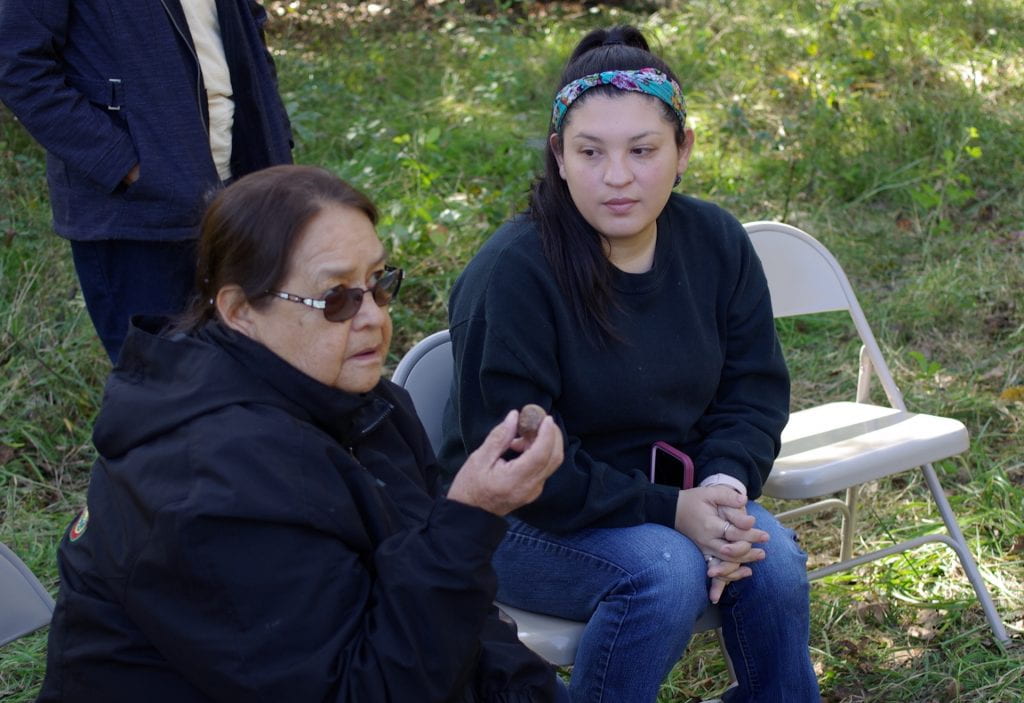
Elder Anna Sixkiller teaches about ᏐᎯ hickory nuts and how to make ᎦᎾᏥ ganatsi. Looking on is our newest CELP student, ᏪᎩ Ashley Dreadfulwater, who we welcomed to the program in September.
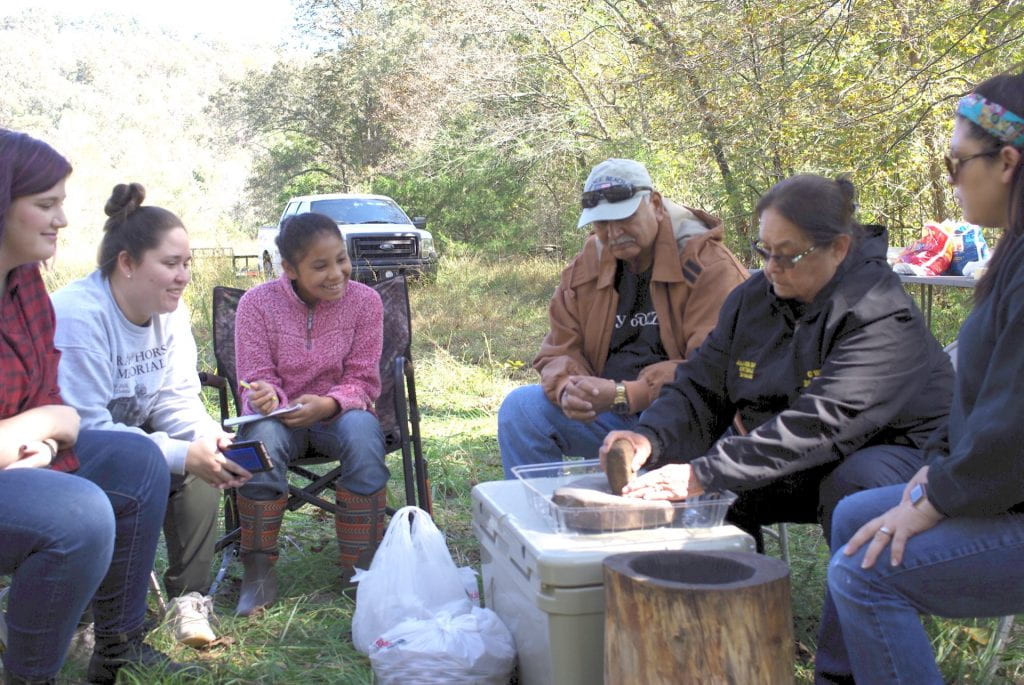
Anna demonstrates how to crack the nuts using a pounding rock.
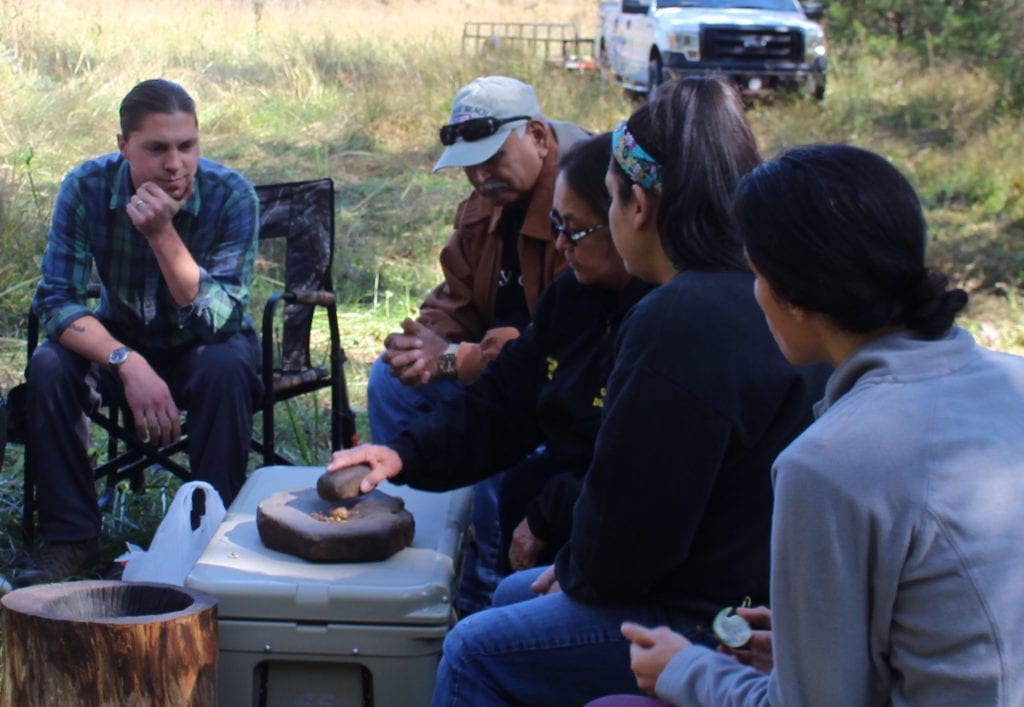
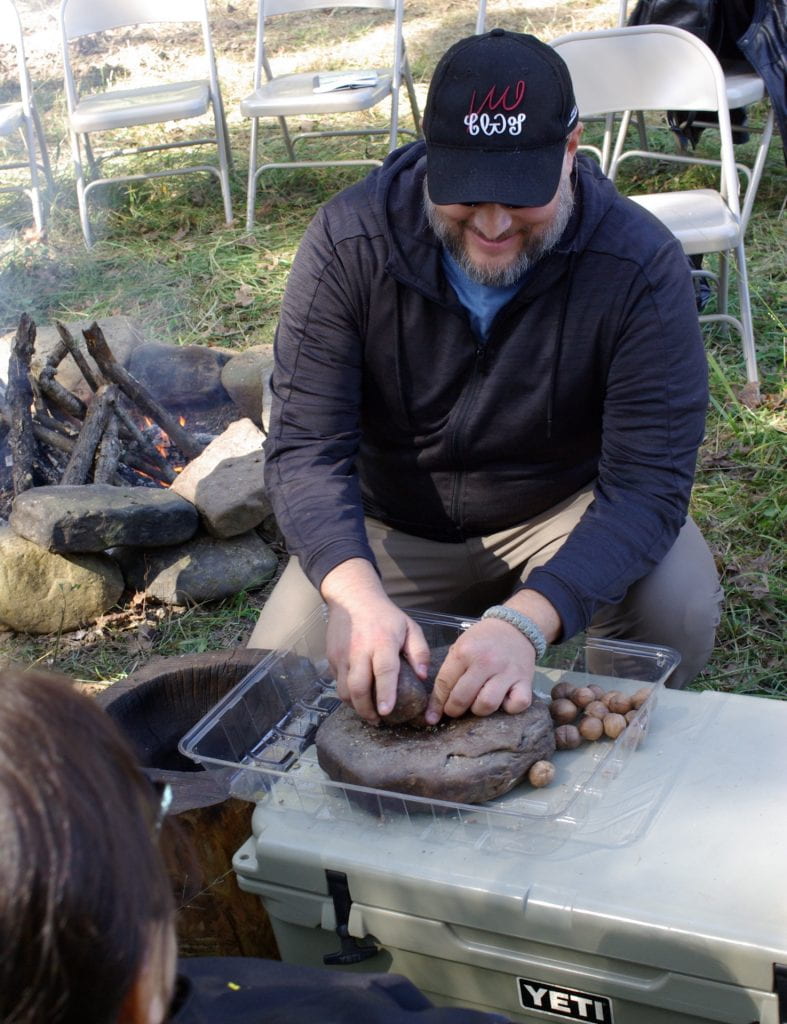
CELP student ᏧᎦᏔ Larry Carney.
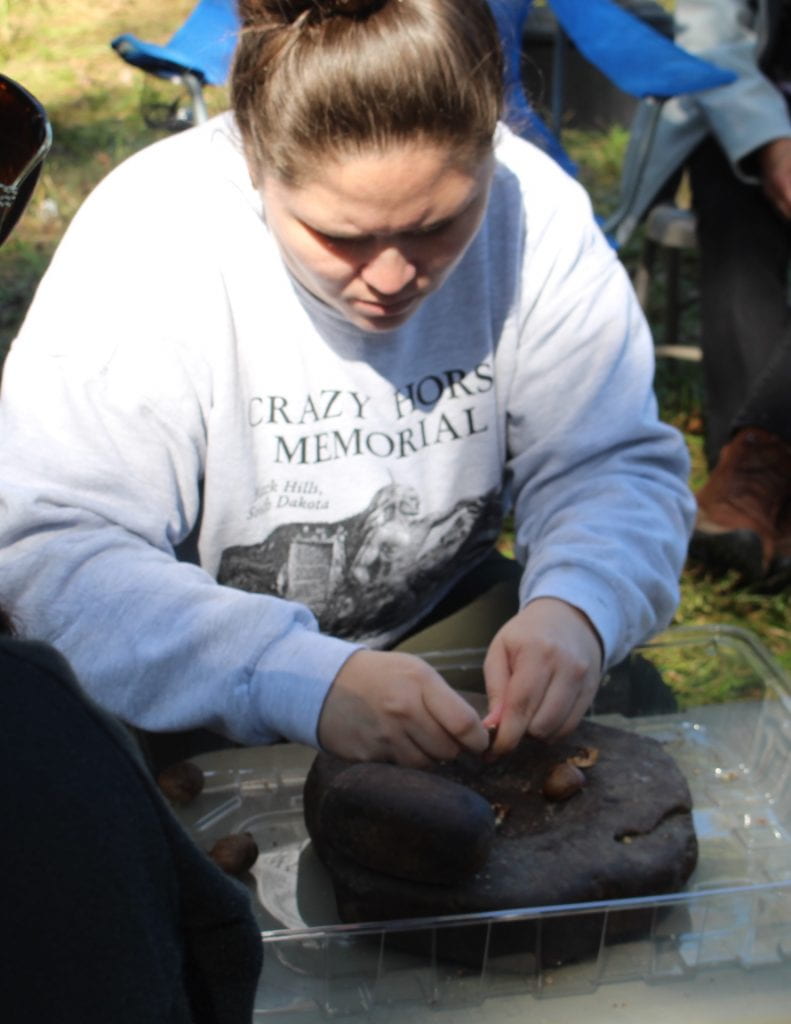
CELP student ᎠᏓᎨ Kakiley Workman.
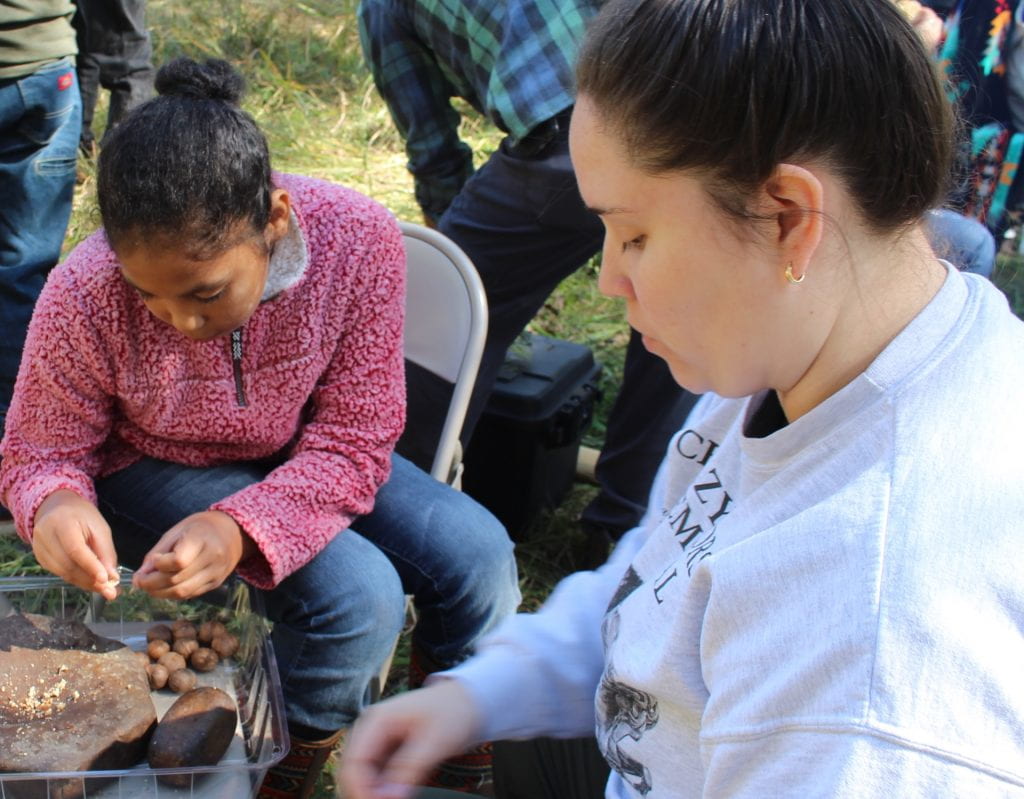
Junior CELP member Cherokee Davis and ᎠᏓᎨ Kakiley Workman.
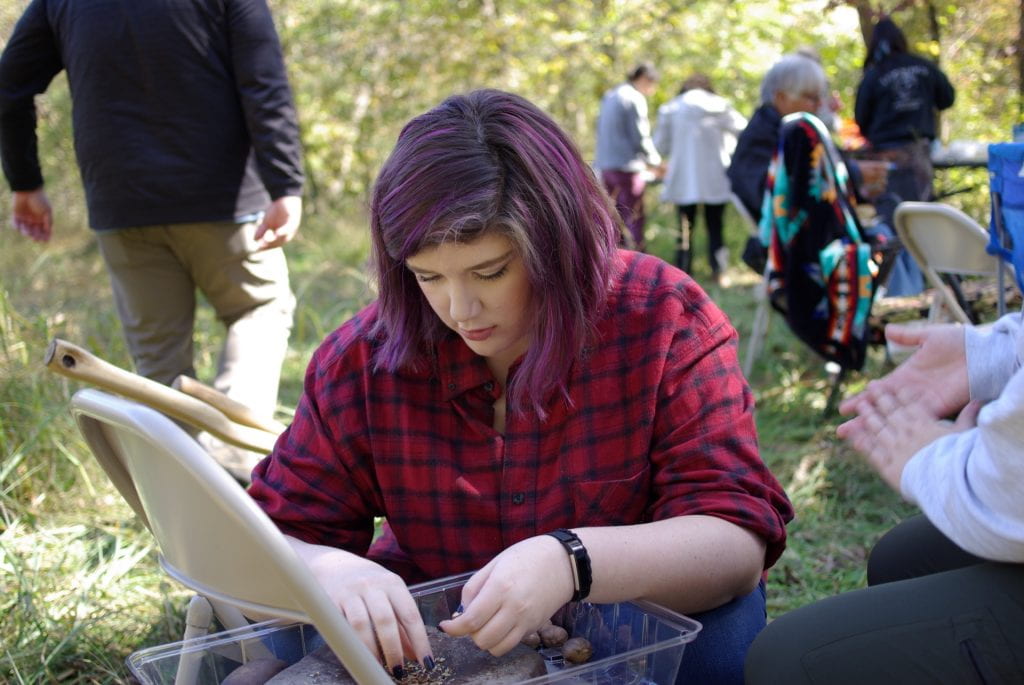
CELP student ᏃᏈᏏ Savannah Anderson.
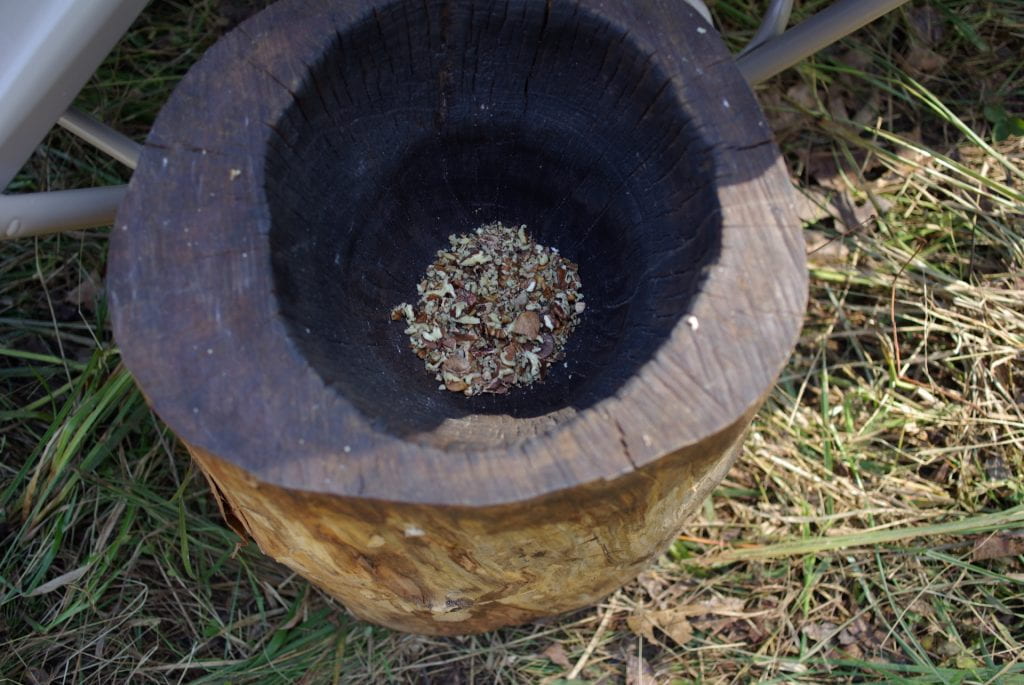
The extracted ᏐᎯ hickory nuts in the ᎧᏃᎾ kanon, ready for pounding.

ᏃᏈᏏ Savannah pounds the nuts using the ᎠᏍᏙᏍᏙᏗ asdosdodi.

As the nuts are pounded, they release their natural oils.
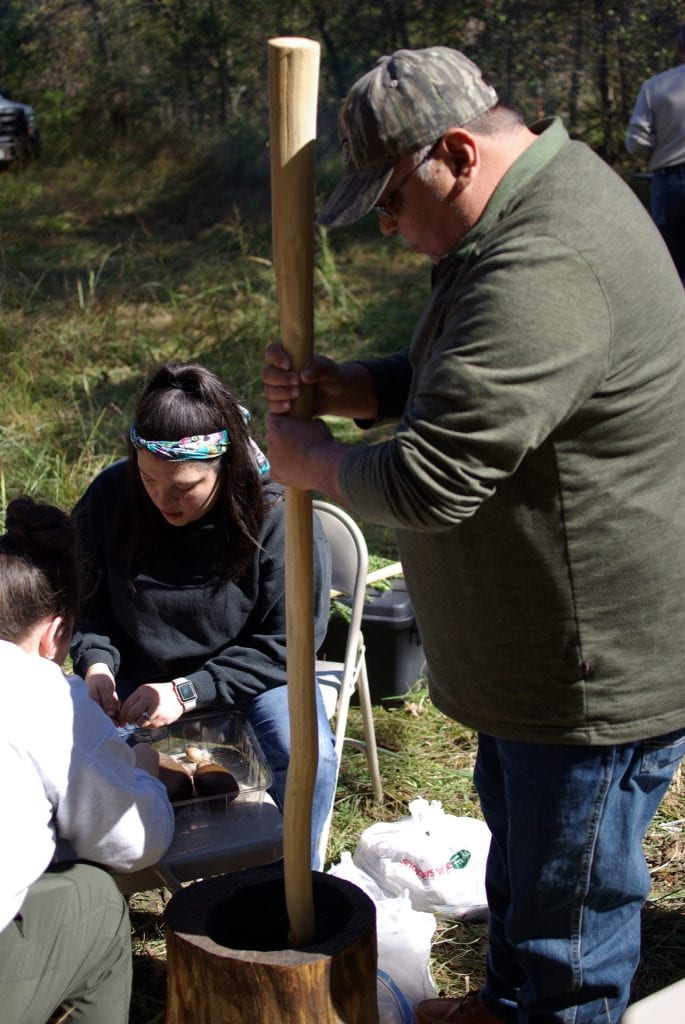
Medicine Keeper Gary Vann.
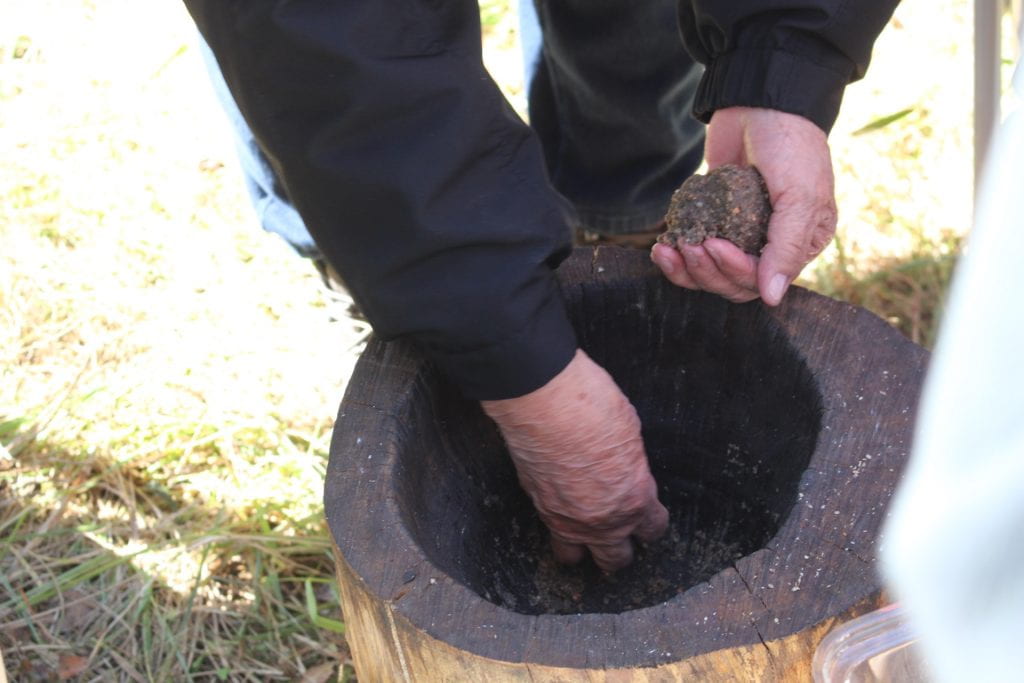
Anna Sixkiller scoops out the pounded nuts and forms a ᎦᎾᏥ ᎠᏍᏆᏞᏍᏗ ganatsi ball.
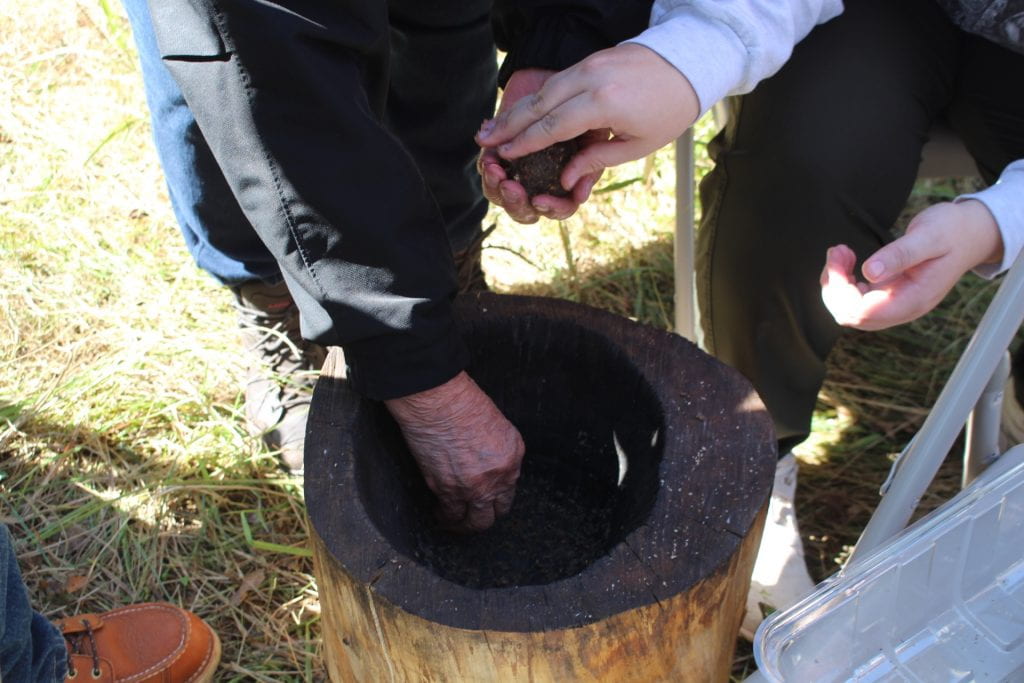

The finished ᎦᎾᏥ ᎠᏍᏆᏞᏍᏗ ganatsi ball, ready to be stored for future cooking.
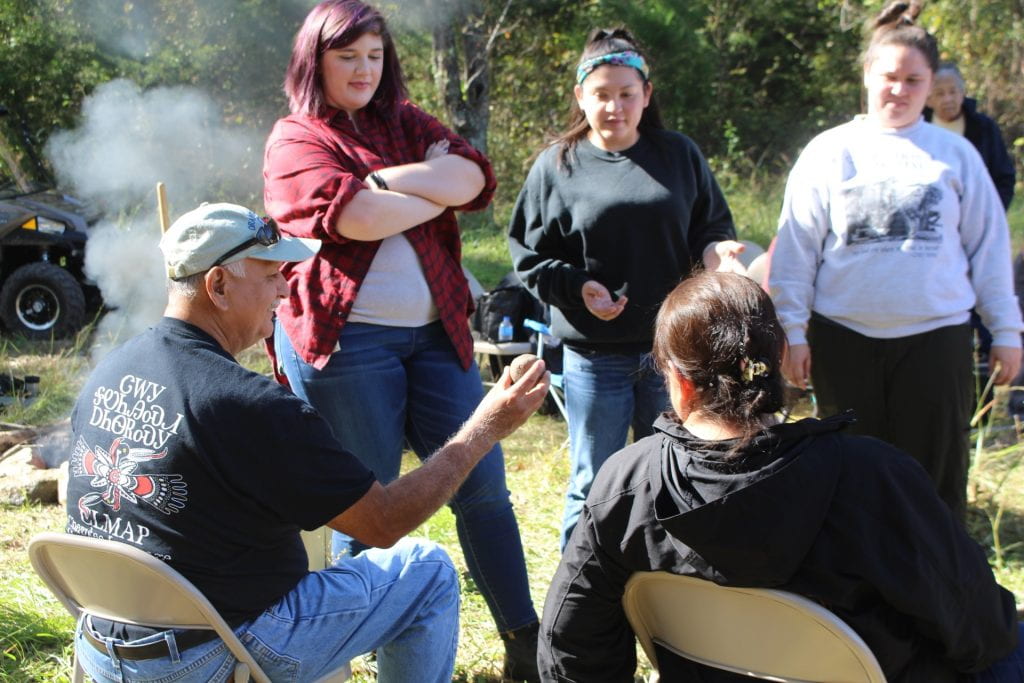
The Medicine Keepers were impressed with how fast the students worked.
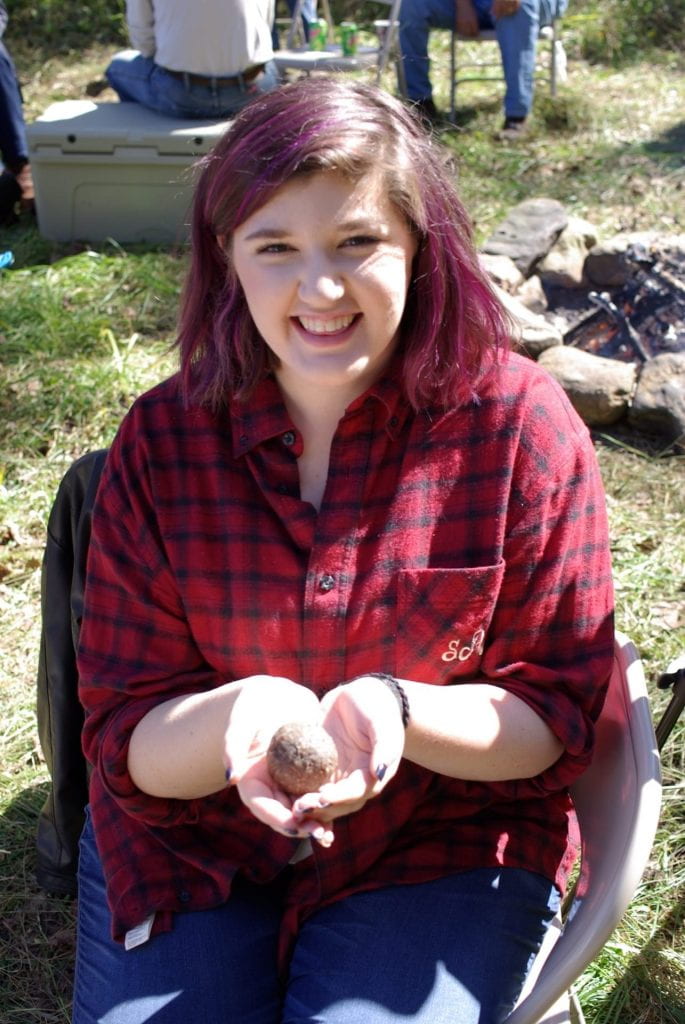
ᏃᏈᏏ Savannah Anderson.

Cherokee Davis and CELP student ᎪᎩ Summer Wilkie with the ᎦᎾᏥ ᎠᏍᏆᏞᏍᏗ ganatsi ball.
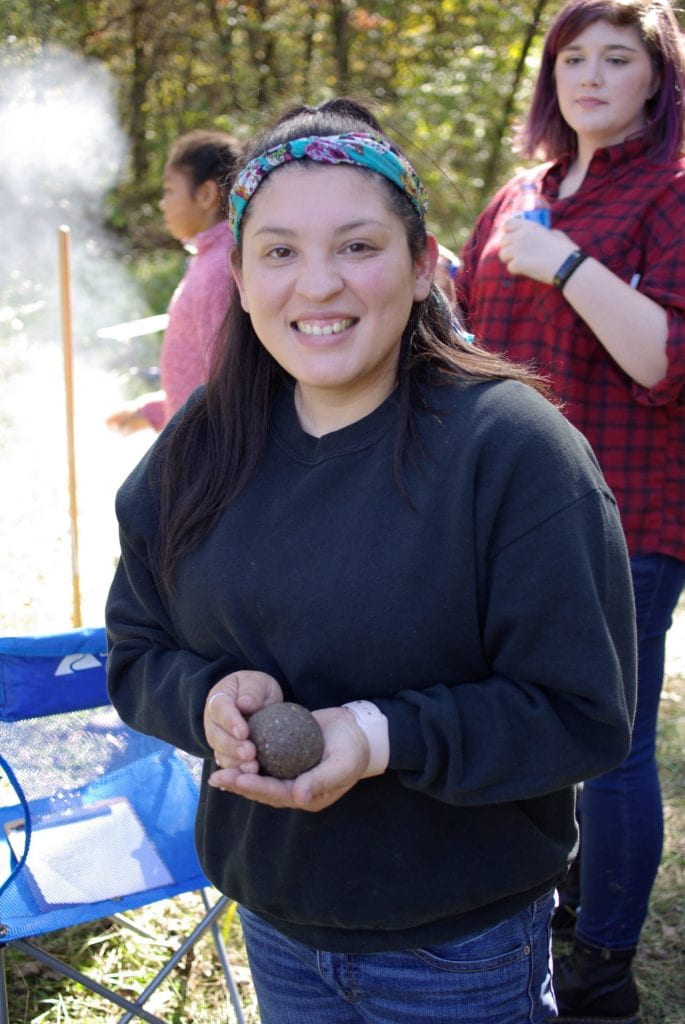
CELP student ᏪᎩ Ashley Dreadfulwater.
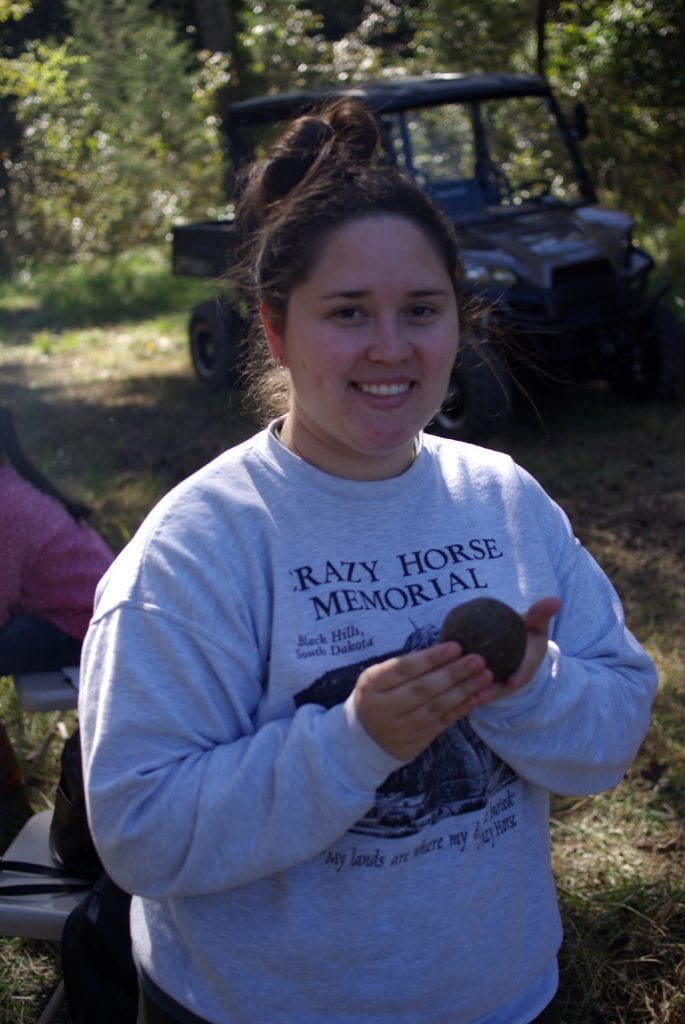
CELP student ᎠᏓᎨ Kakiley Workman.

CELP student ᏧᎦᏔ Larry Carney.
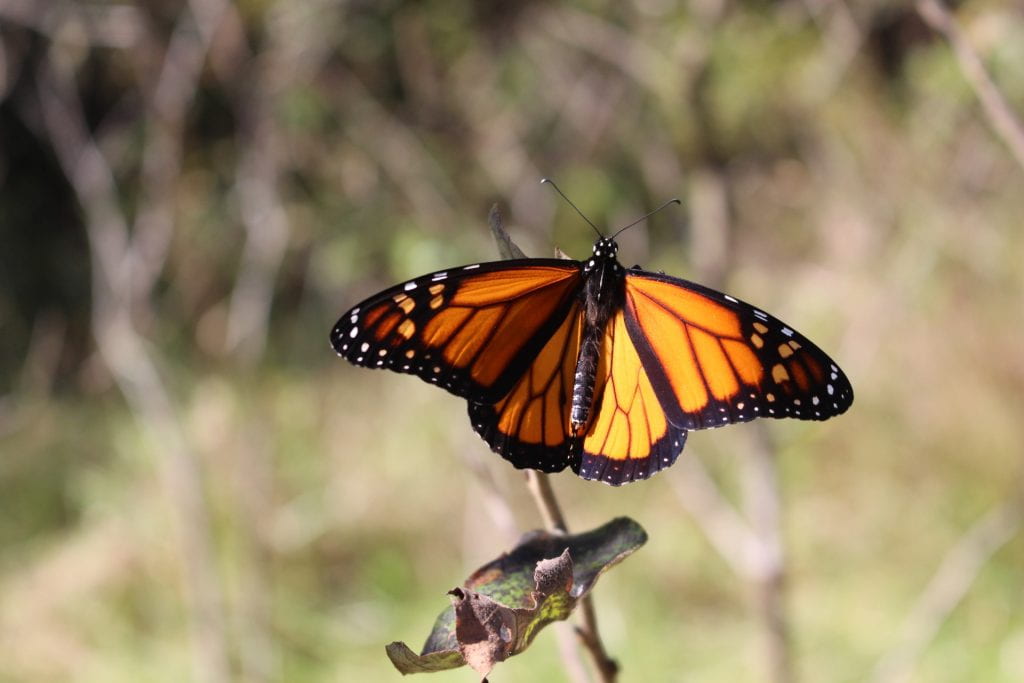
We were blessed with clear skies and visits from numerous monarch butterflies throughout the day.
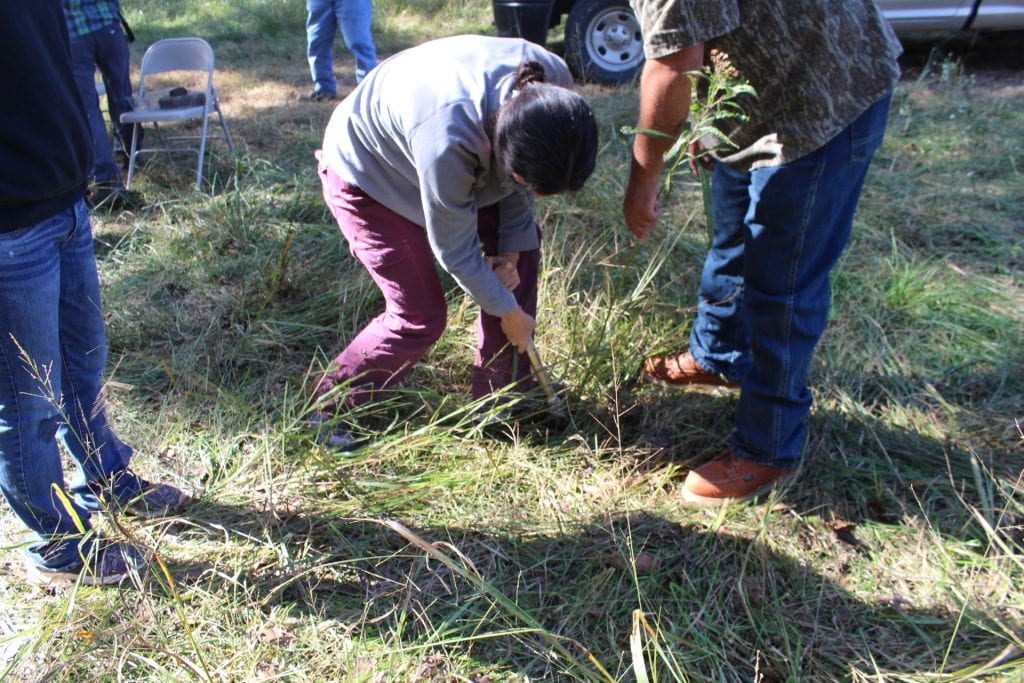
Medicine Keeper ᎠᏧᏣ Gary Vann instructs ᎪᎩ how to dig the root of a medicine plant, ᏒᎾ Baldwin’s Ironweed.

ᏪᎩ and ᎪᎩ inspect the root of a ᏒᎾ, Baldwin’s Ironweed.
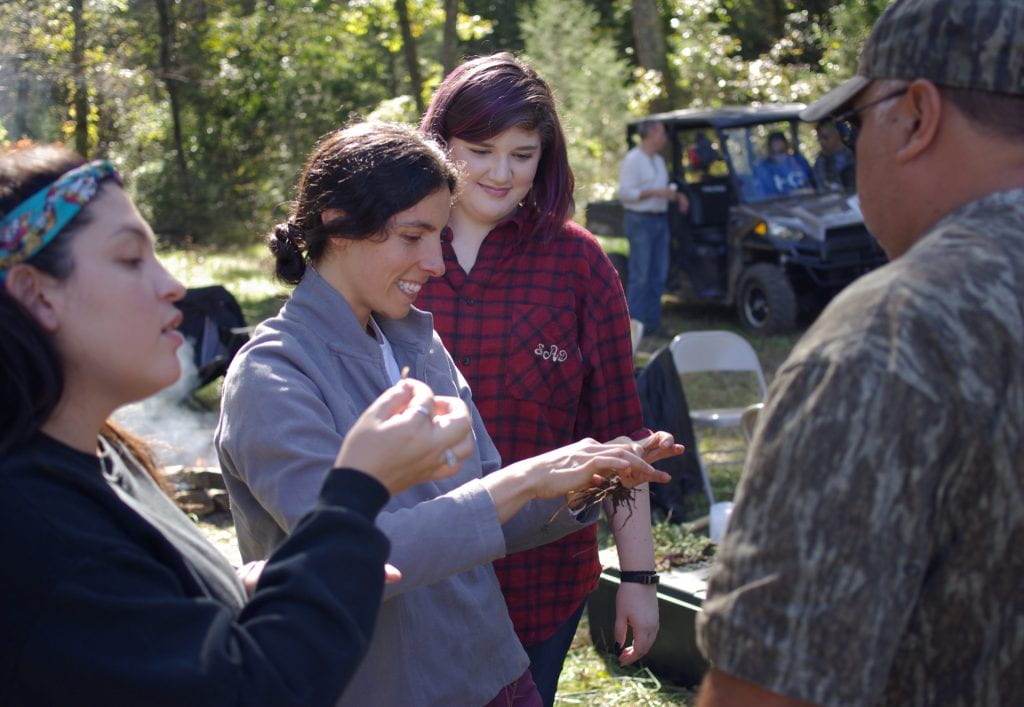
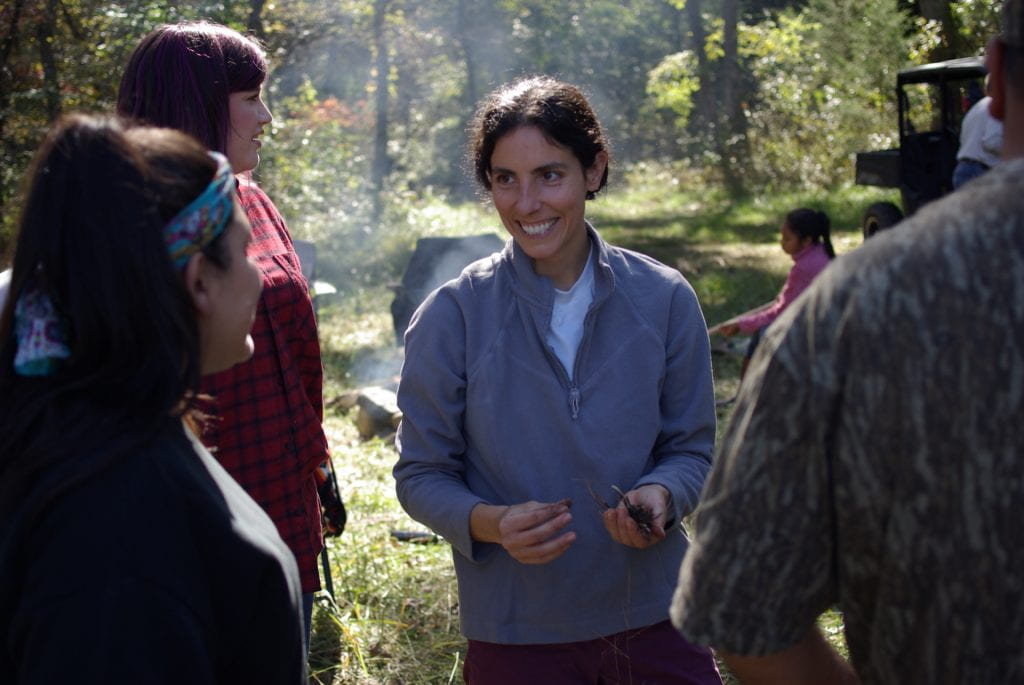
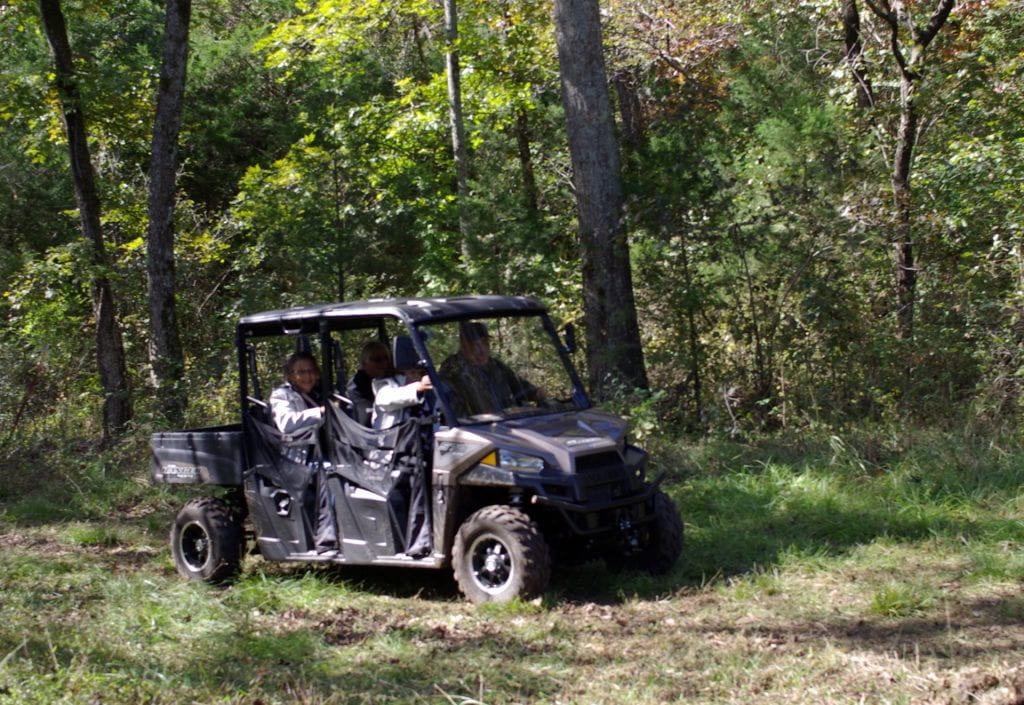
Medicine Keepers Bonnie Kirk, Phyllis Edwards, Sammy Still, and Gary Vann ride in the UTV to access our tract of land.
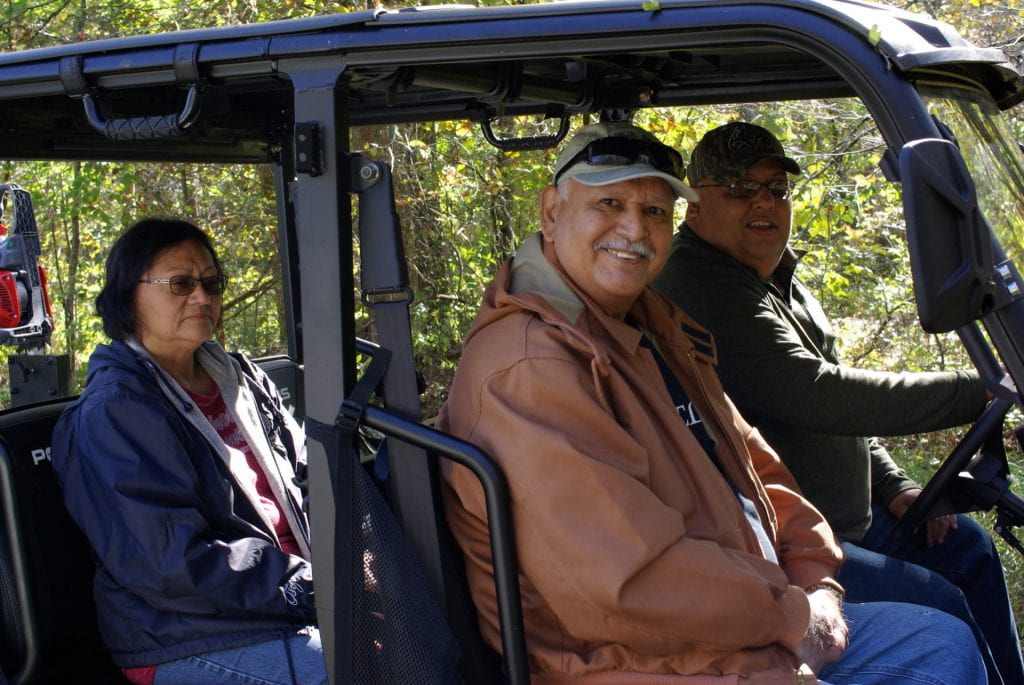
Medicine Keepers Nancy Scott, John Ross, and Gary Vann.
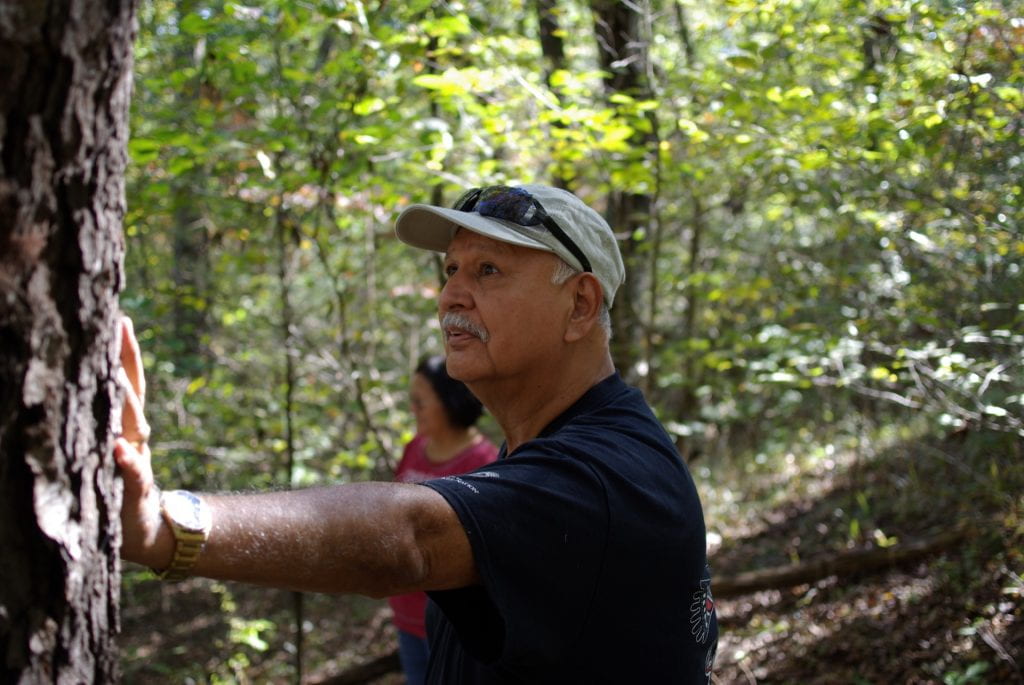
John Ross discusses the medicinal uses for ᎩᏔᏯ, wild cherry tree.
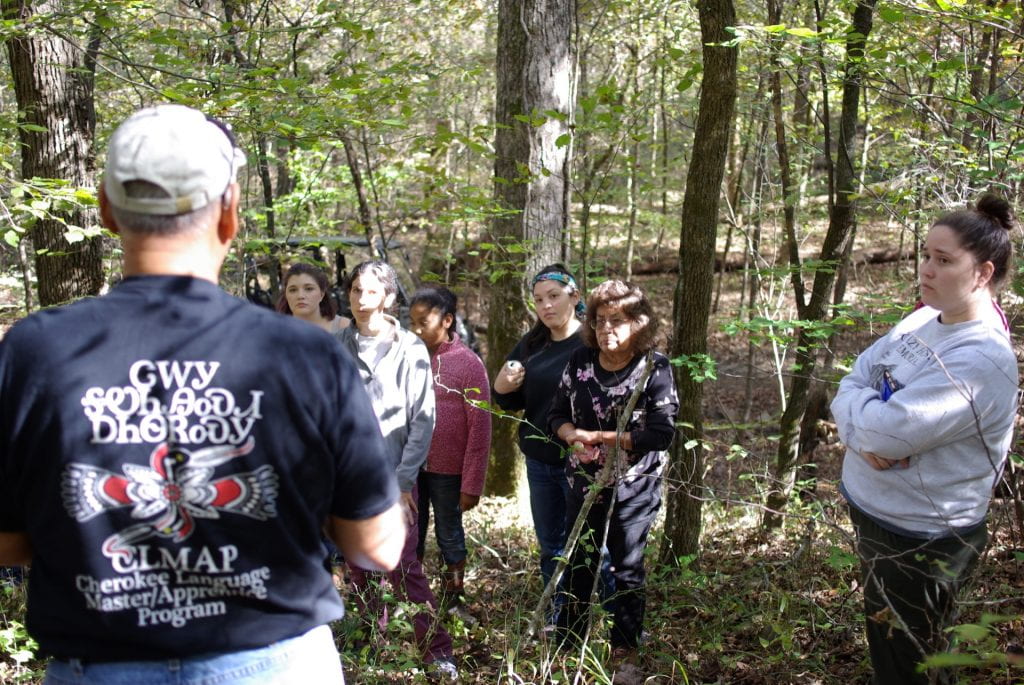
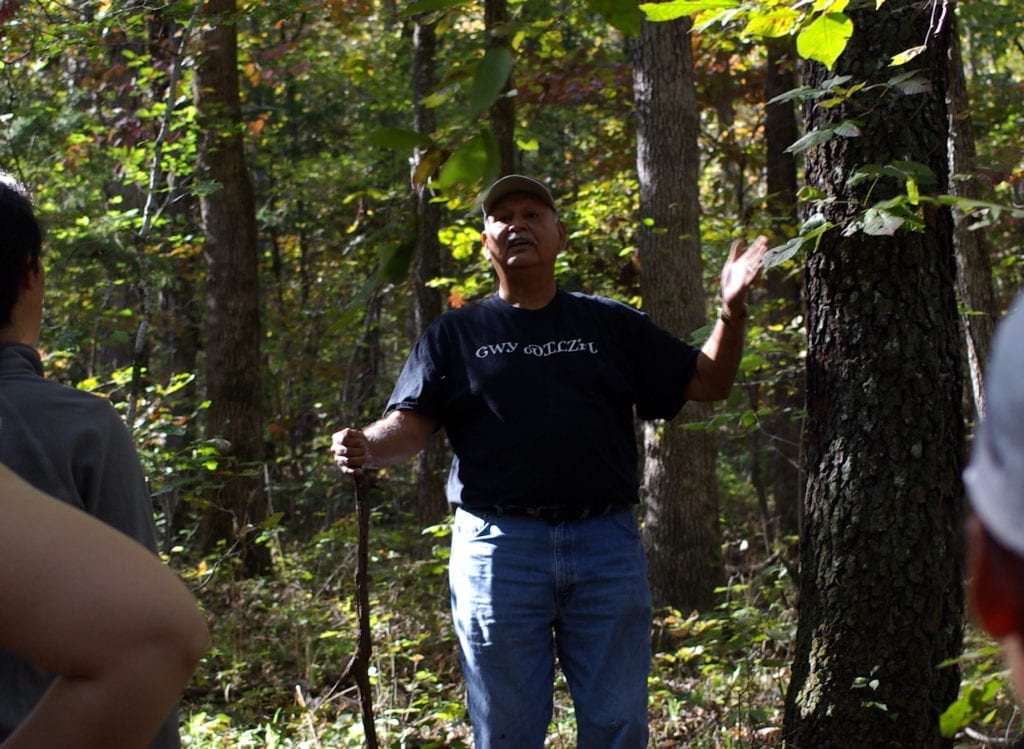
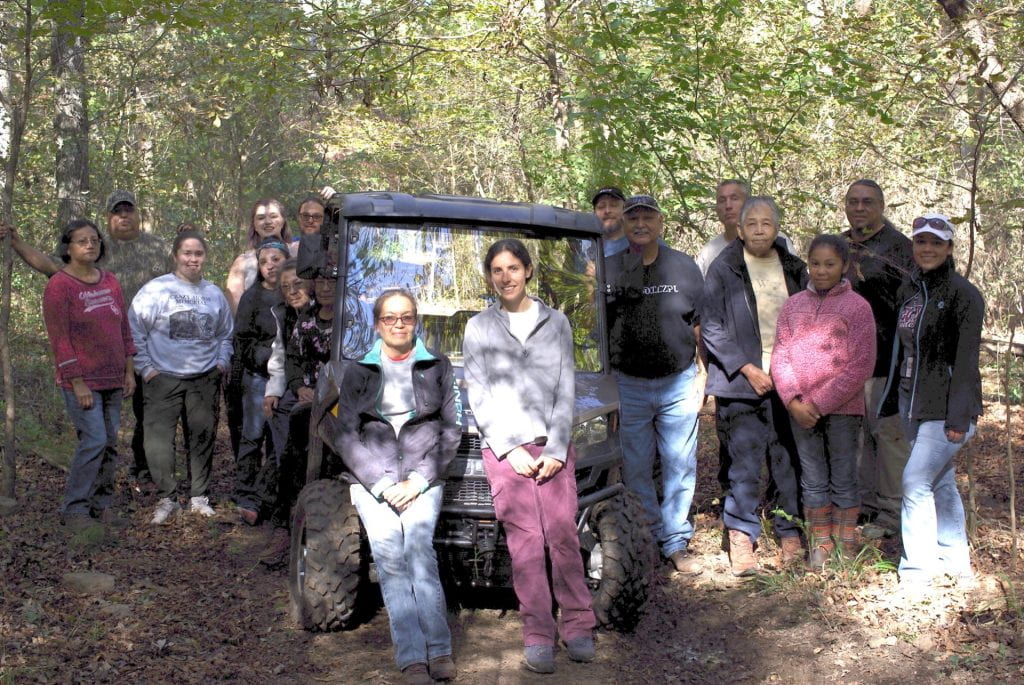
Group photo of Medicine Keepers, students, and staff on the trail at our site.
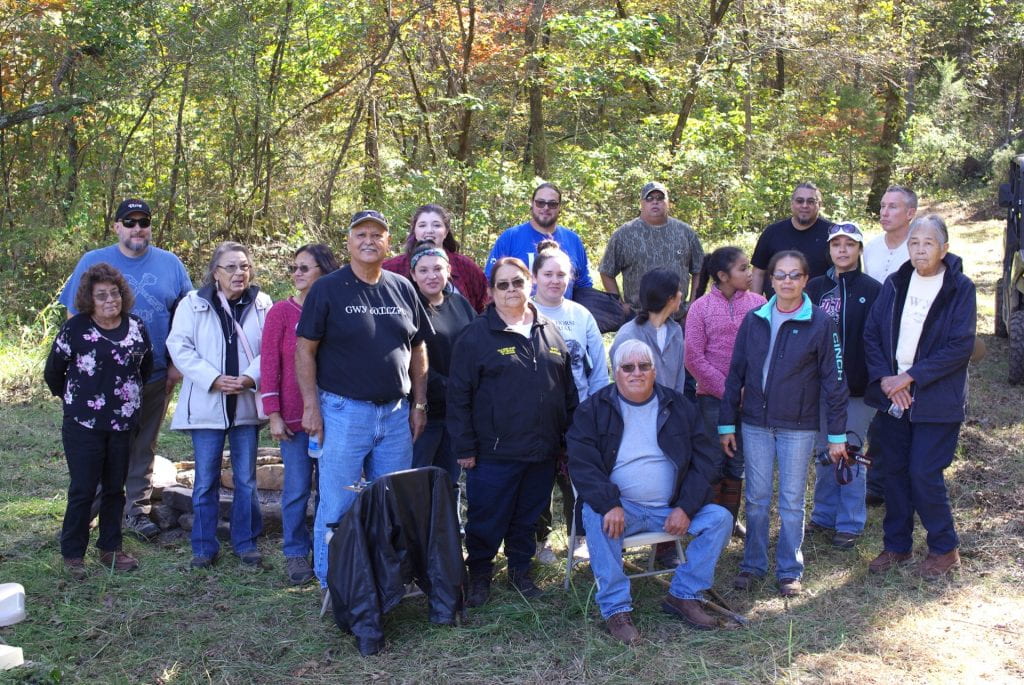
Group photo at the trailhead, closing out the day. Standing from left to right: Phyllis Edwards, Larry Carney, Bonnie Kirk, Nancy Scott, John Ross, Ashley Dreadfulwater, Savannah Anderson, Anna Sixkiller, Kakiley Workman, Ryan Mackey, Gary Vann, Summer Wilkie, Cherokee Davis, Nancy Rackliff, Kevin Daugherty, Feather Smith, Pat Gwin, Margaret Leuthje. Seated: Sammy Still.
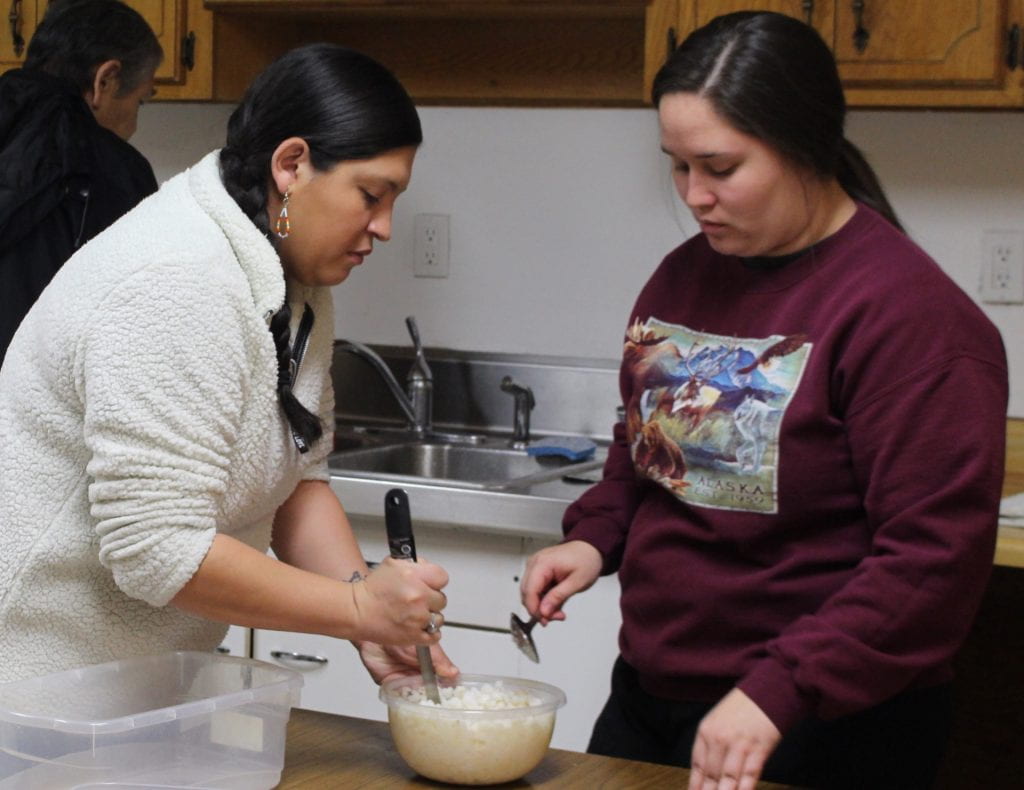
ᏪᎩ and ᎠᏓᎨ prepare ᎠᎹᎨ hominy for the ᎦᎾᏥ ganatsi during our meeting in November.
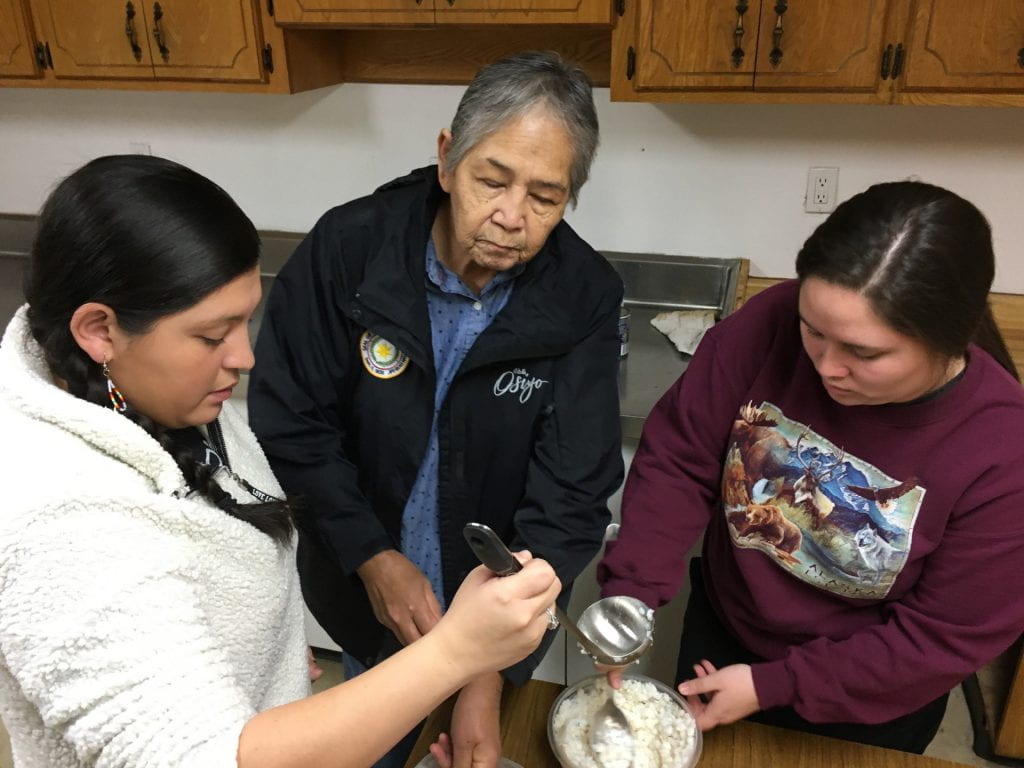
Elder Margaret Leuthje instructs the students.
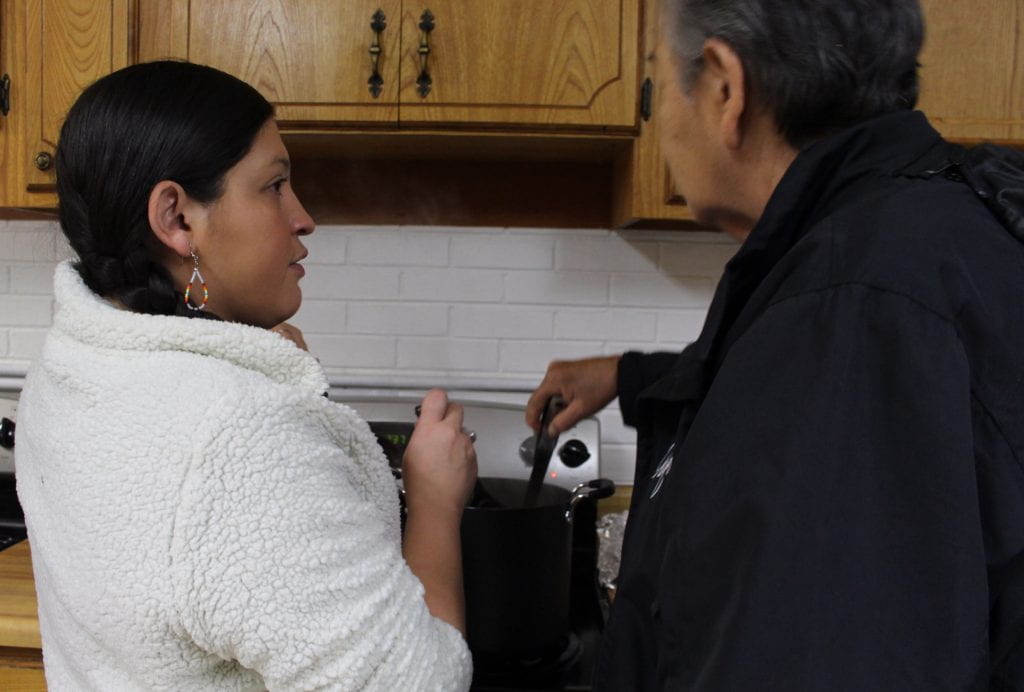
The ᎦᎾᏥ ᎠᏍᏆᏞᏍᏗ ganatsi ball is broken up and cooked in boiling water.
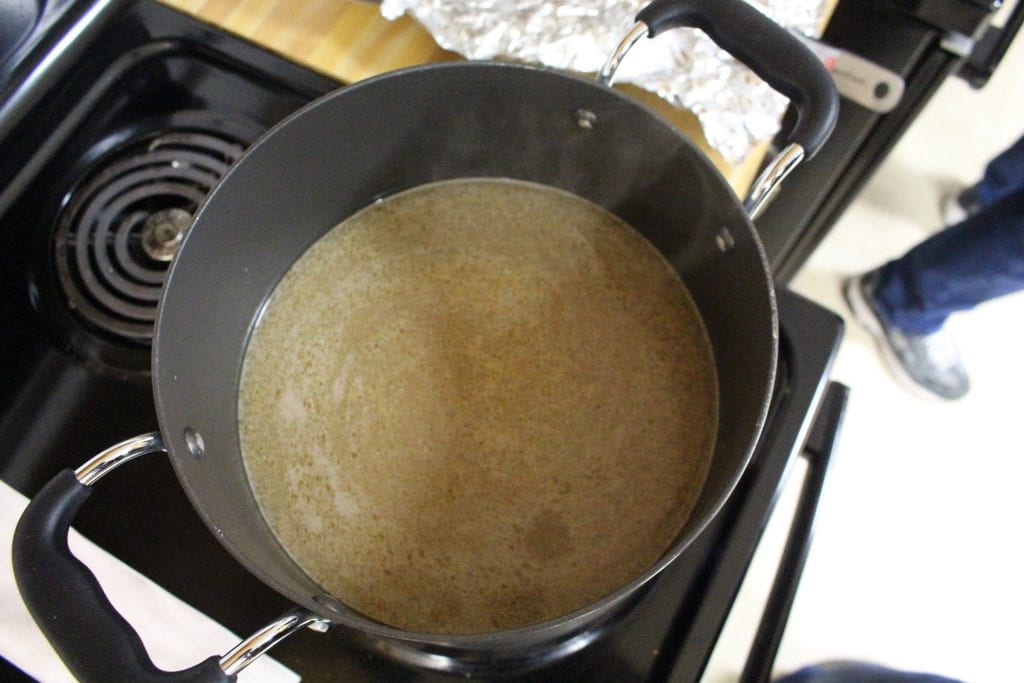
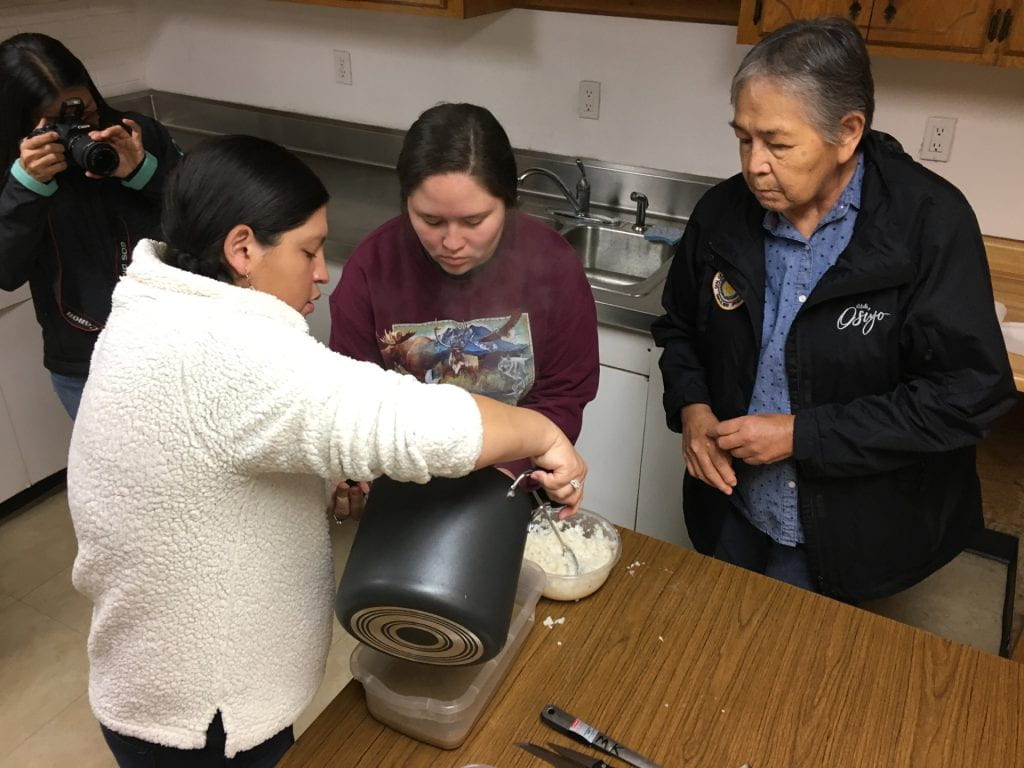
The students strain the ᎦᎾᏥ ganatsi through a sifter to remove the pieces of shell.
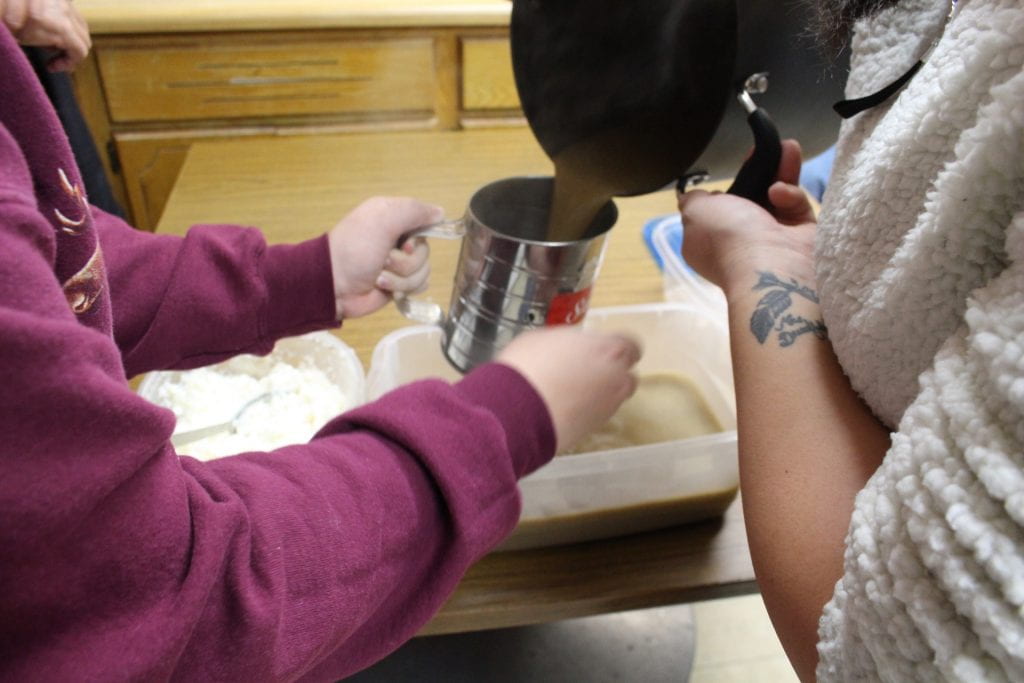
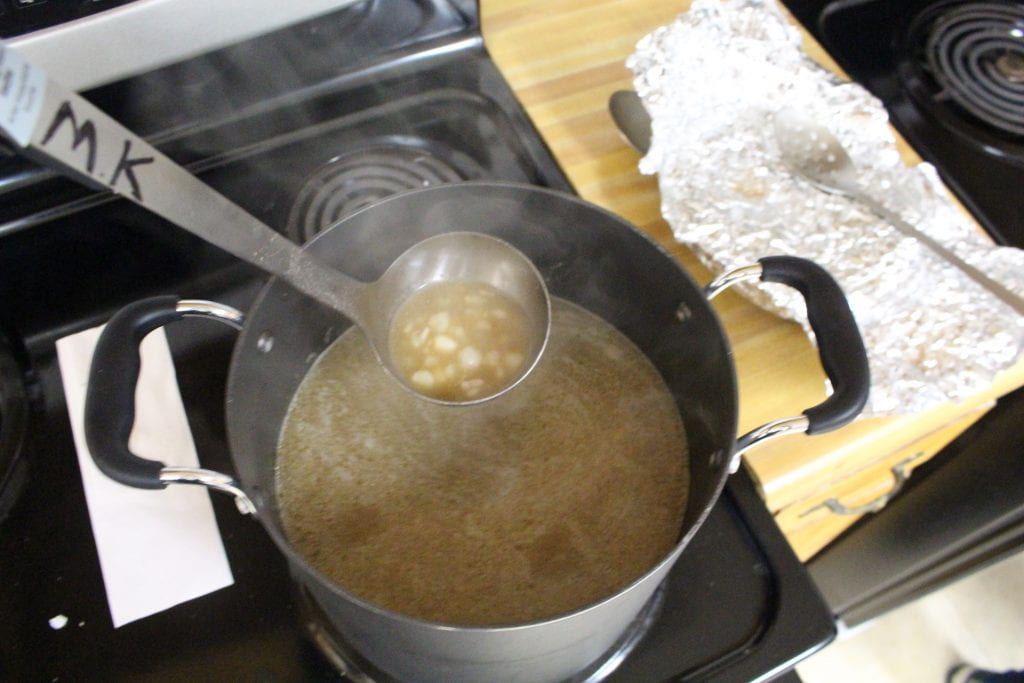
ᎠᎹᎨ hominy is added, and the ᎦᎾᏥ ganatsi is ready. You can then add sugar, salt, or eat the ᎦᎾᏥ ganatsi as-is.
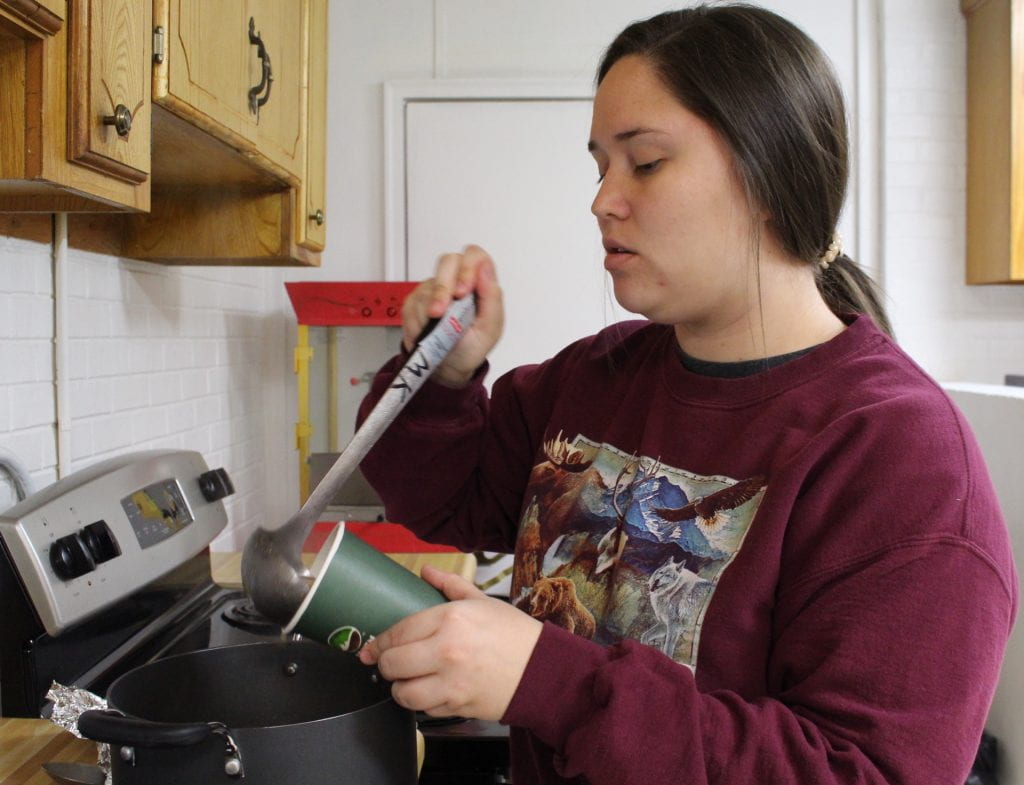
ᎠᏓᎨ serves the finished ᎦᎾᏥ ganatsi.

Ed Fields and Margaret Leuthje enjoy the ᎦᎾᏥ ganatsi. The Elders all gave it a “thumbs up.”
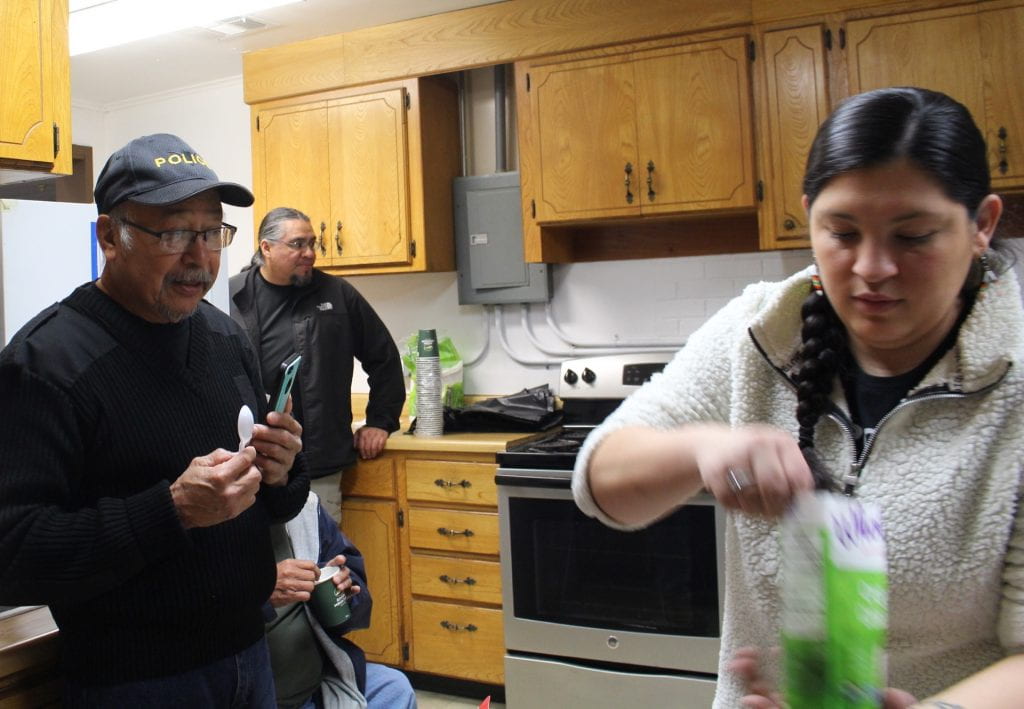
We were glad to have our friend from Kenwood, Alben Mouse (left), join us for our cooking activity that day. Also pictured in SNR staff, Kevin Daugherty (middle).

It’s not a Cherokee gathering without laughter.
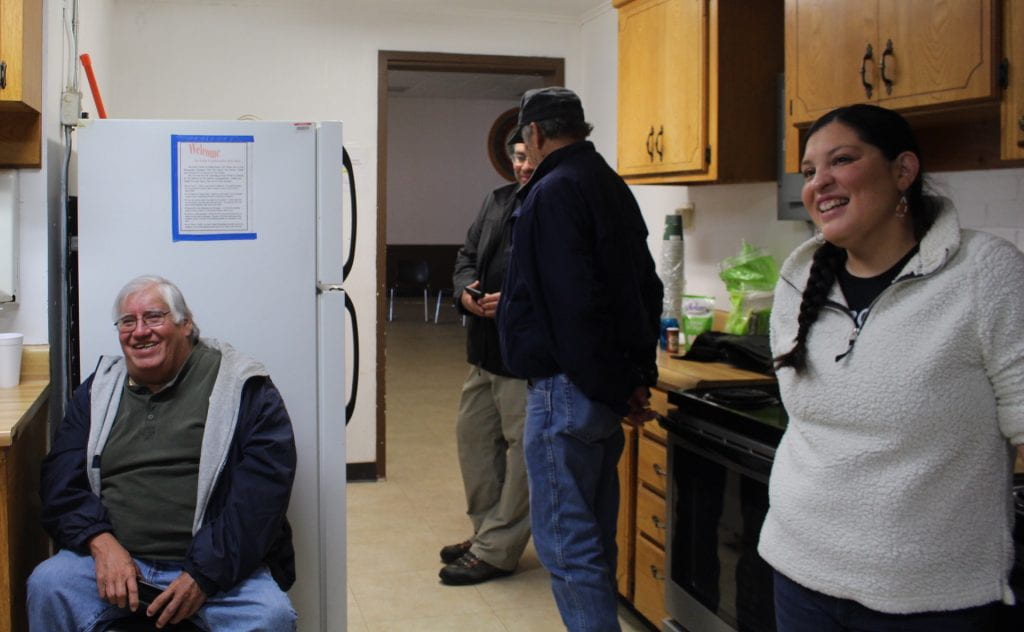
Pictured (L to R): Sammy Still, Kevin Daugherty, Ed Fields, Ashley Dreadfulwater.

Due to record flooding in northeastern Oklahoma, our June 2019 meeting had to be relocated from our Adair county land tract to the tribal complex in Tahlequah. We used this opportunity to repeat the Fall 2018 lesson of making traditional cornbread from scratch, as well as to discuss the program so far and plan for future activities. Repeating this activity allowed the students to gain a better grasp of the process. Overall, this meeting was a good opportunity to take stock of the first year of the program and to envision next steps together. Elder Crosslin Smith also prepared a special lesson for the students around sacred Keetoowah symbolism and its meaning.
Over the past year, we have held numerous community meetings to introduce the research project and the research team (CELP students and Principal Investigator Carroll). This process is an instrumental part of a community-based research project. We successfully coordinated introductions with three Cherokee communities: Greasy, Marble City, and Kenwood. We began this process in Fall 2018, and continued to meet with community leaders and attend community events in Spring 2019, in conjunction with the planned group activities for the education program. In June 2019, we began the community surveys to enlist participants into the study and acquire referrals. We totaled 30 surveys (11 Kenwood, 16 Marble City, 3 Greasy). Our goal is 30 in each community, so we will be returning in the Fall to complete this phase of the research.
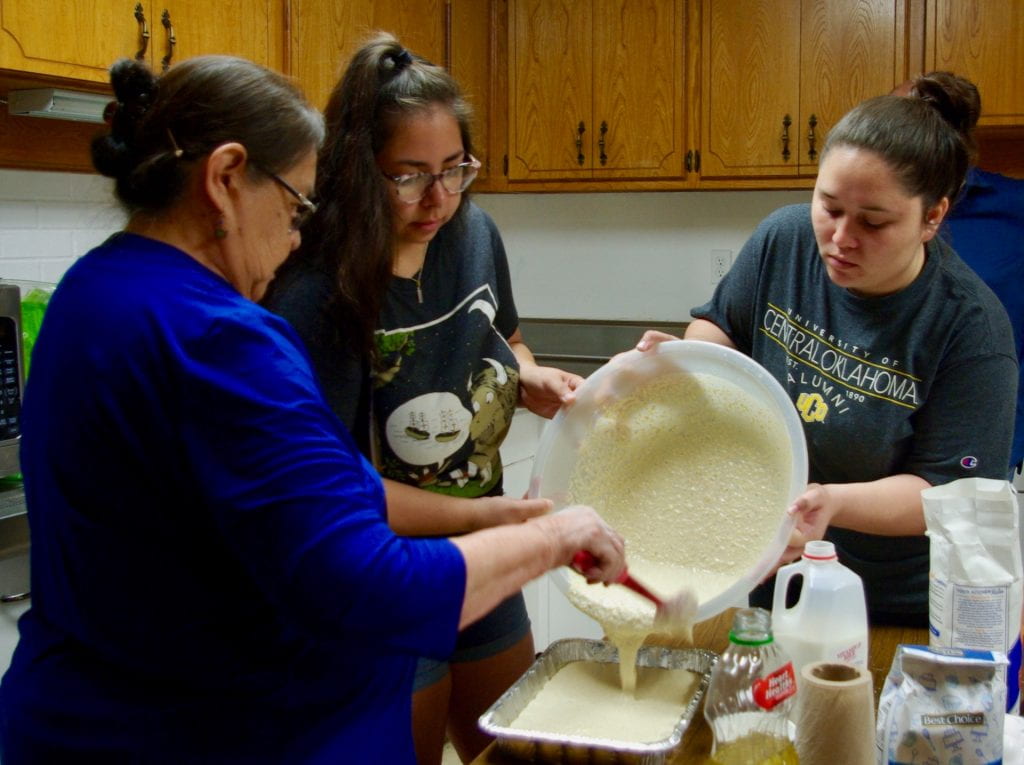
Anna Sixkiller prepares traditional cornbread with Sky Wildcat and Kakiley Workman.
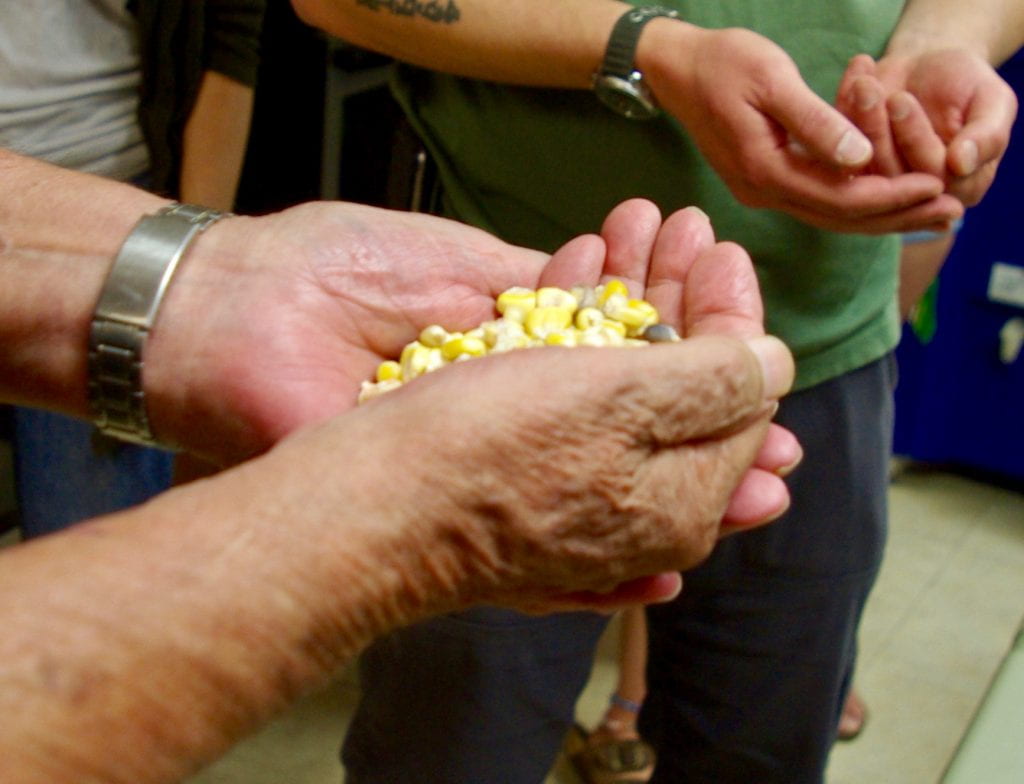
Crosslin Smith holds kernels of heirloom corn, ᏎᎷ.
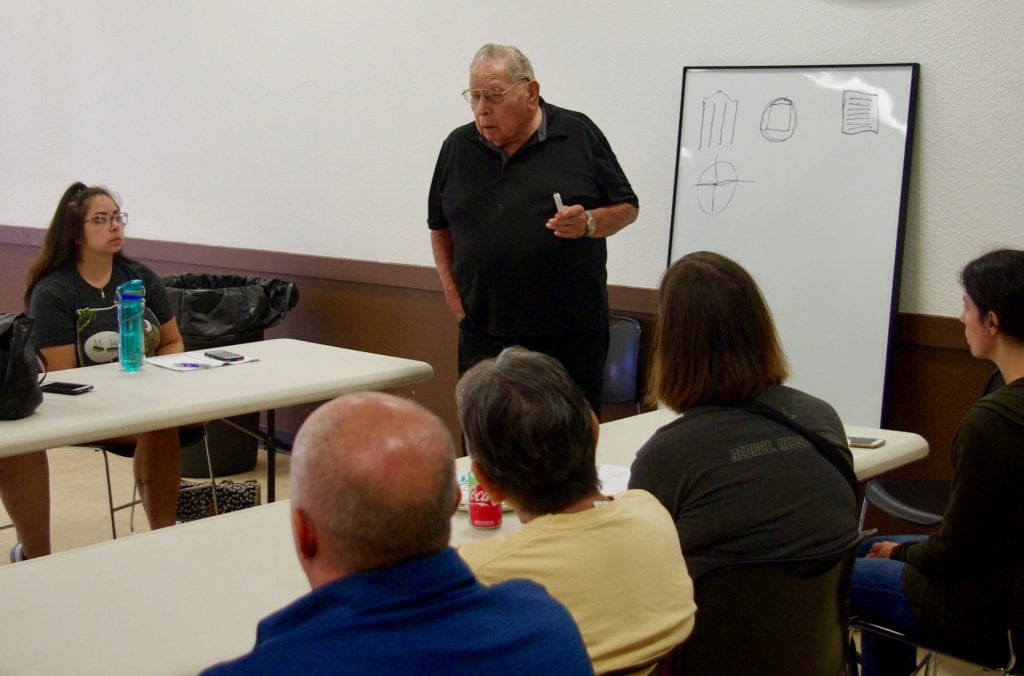
Crosslin Smith gives a lesson on ancient Keetoowah symbolism.
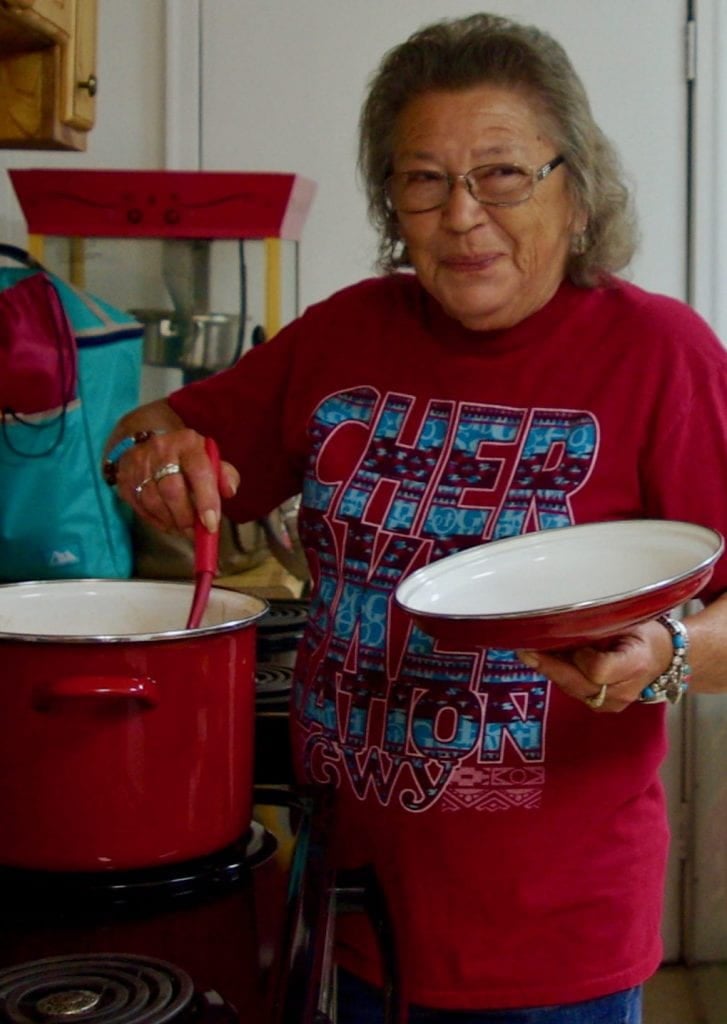
Bonnie Kirk attends to a pot of ᏚᏯ (beans).
Our tribal newspaper (and the oldest of its kind), the Cherokee Phoenix, published an article on the Cherokee Environmental Leadership Program. Click here to read the piece by reporter Lindsey Bark and to hear from some of our students and Medicine Keepers on the program so far.
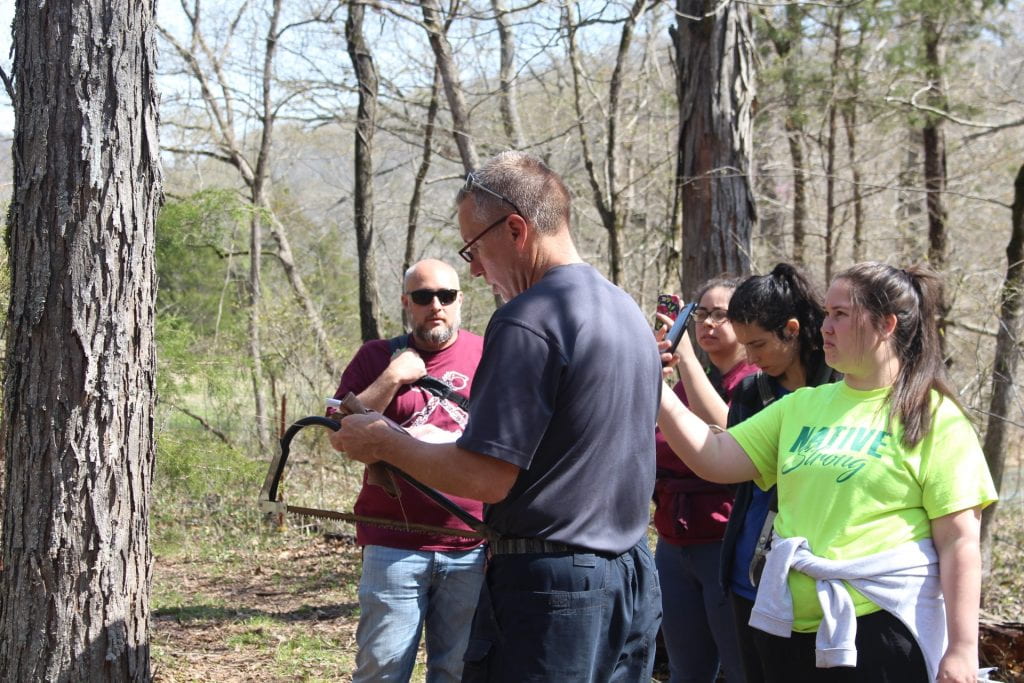
CELP students (from left) Larry Carney, Sky Wildcat, Summer Wilkie, and Kakiley Workman learn about Shagbark Hickory trees with Tribal Biologist Pat Gwin (center, foreground).
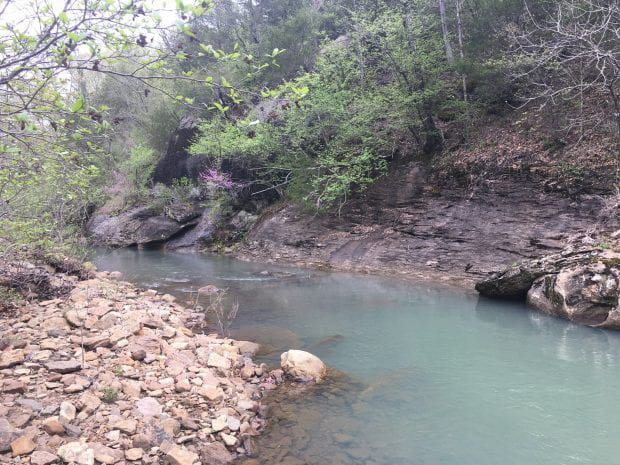
For our spring group activity in April, we met at the site of our new “home” — a remote tract of land in Adair county that has been designated as a tribal conservation area for education and the protection of abundant culturally-significant plants and animals. Students and staff began work in early spring to create a trail and clear an area where we will construct a permanent pavilion for future meetings and activities. Our work to connect the elders and youth at this special place is further supported by a generous grant from the Indian Land Tenure Foundation.
It was a rainy and cold day, so we set up at the perimeter of the site to discuss numerous medicinal plants with the elders. Elder and spiritual leader Crosslin Smith began the meeting with a prayer and blessing for the site and all our future activities there. We had a simple lunch around a fire and discussed the plants that some brought from home, and others that had been collected by staff at the site shortly after we arrived. We also had a chance to transplant a Dwarf Prairie Willow cutting from a roadside to our group home with the hope that this important plant will establish itself there.
We are blessed to be doing this work with the support of numerous organizations and individuals, and I’m excited to have inaugurated our new “home” that we hope will be a site of learning, relationship-building (with the land and with each other), and for the practice of our land-based knowledge today and into the distant future.
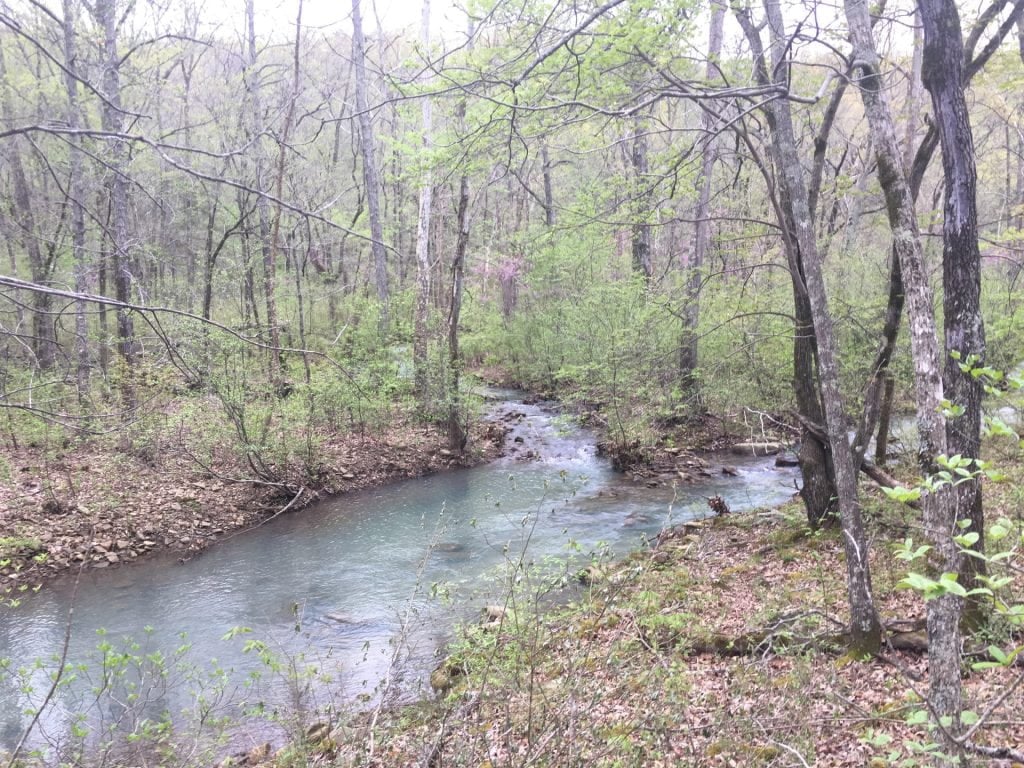
The creek flowing through our new home.
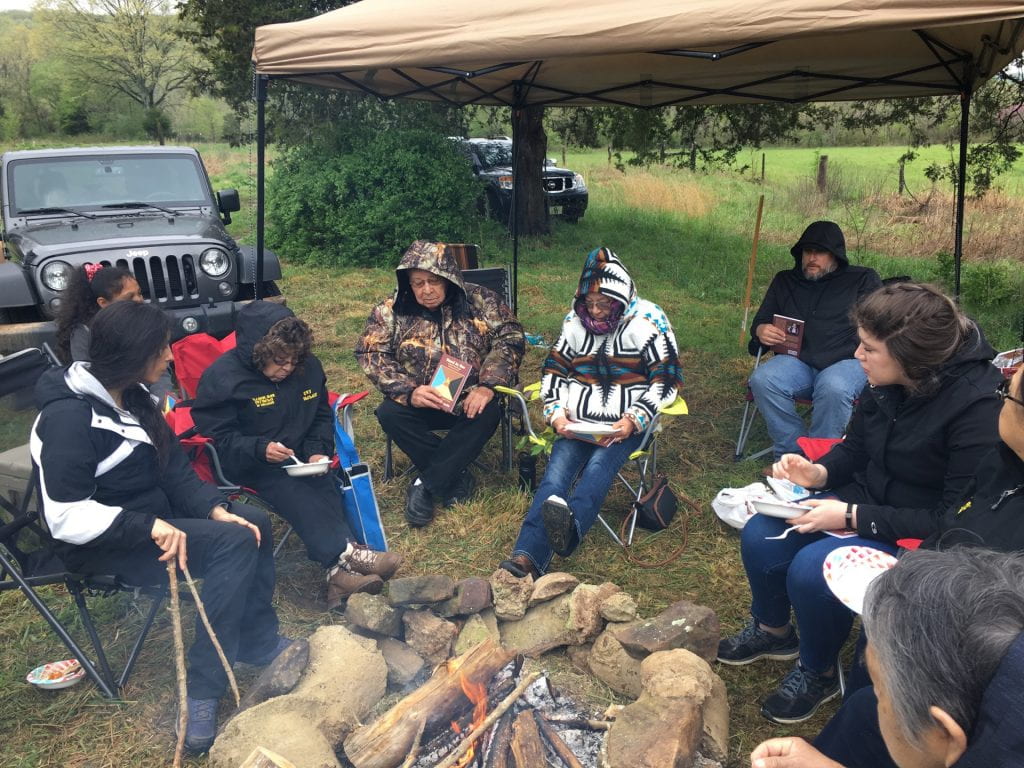
Spiritual Leader Crosslin Smith (4th from left) discusses the importance of the land and our mission to protect and learn about the plants.
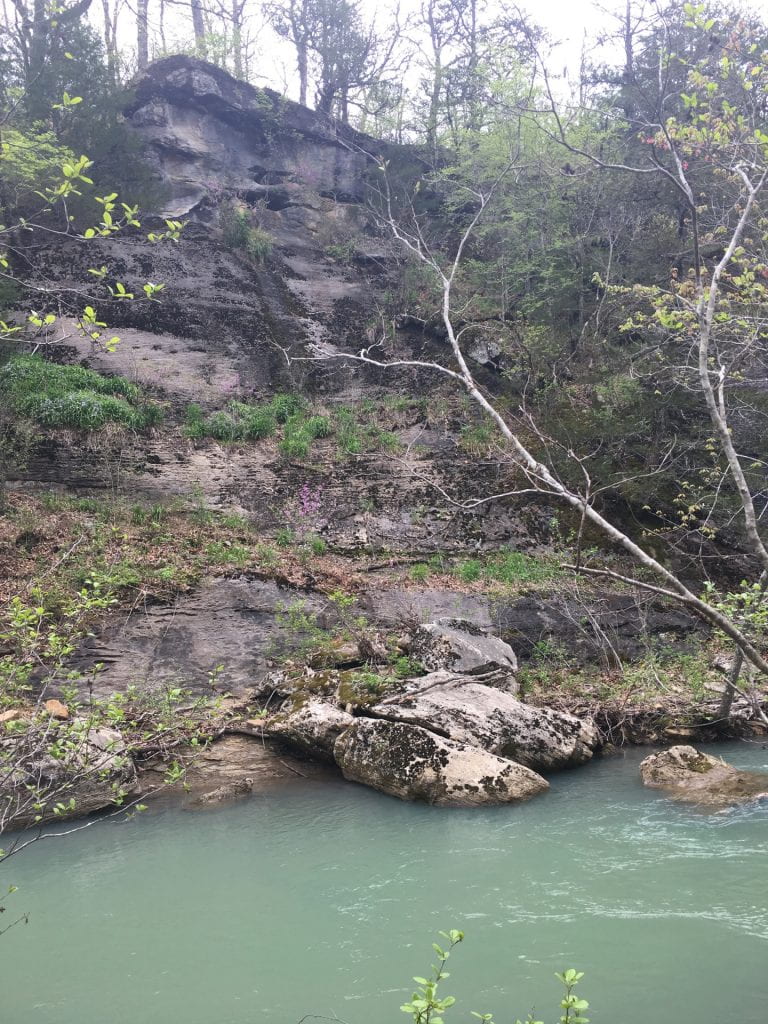
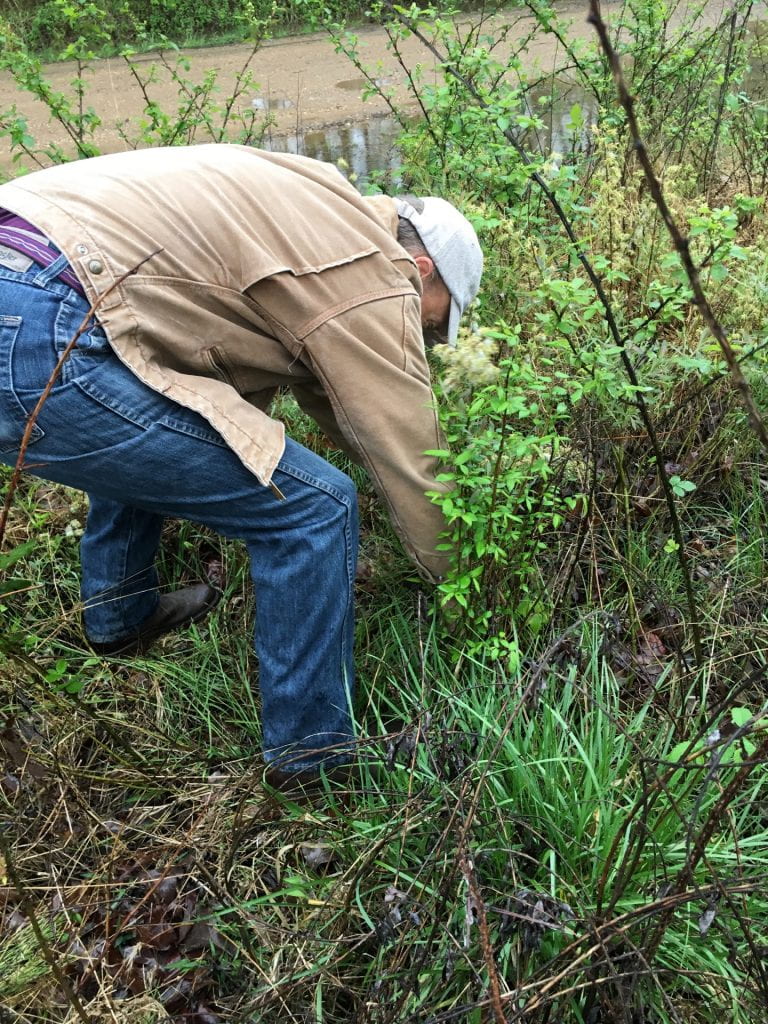
Pat Gwin makes a cutting from a Dwarf Prairie Willow (ᏗᎵᎦᎵᏍᎩ ᎤᏍᏗ) for transplanting.
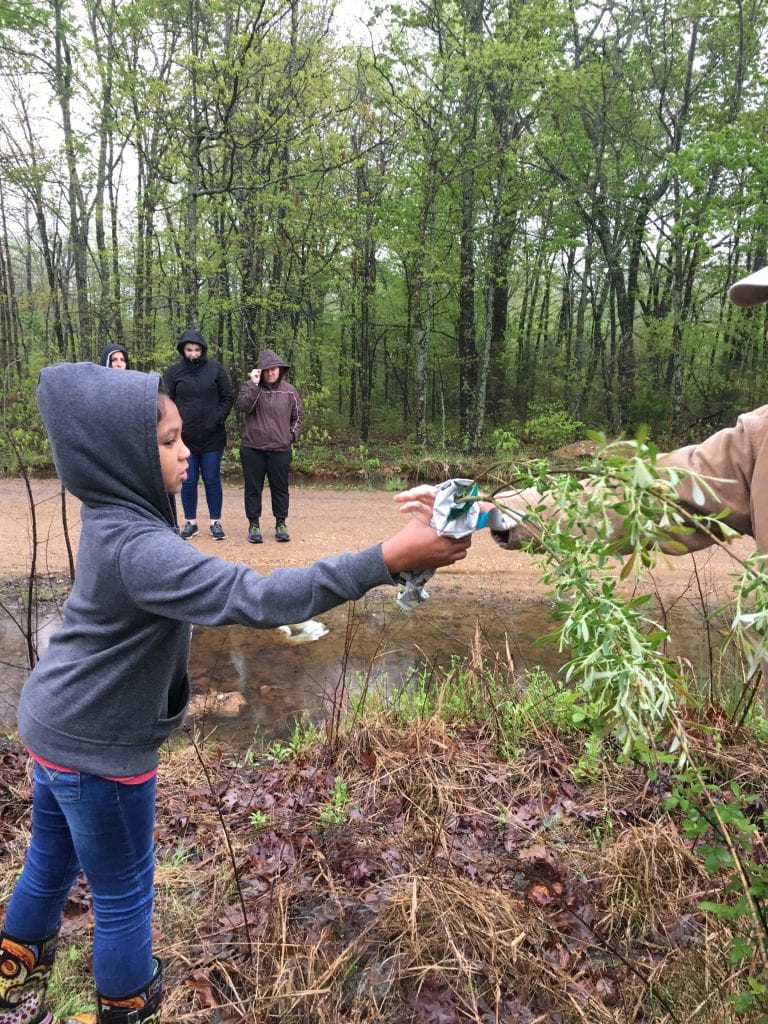
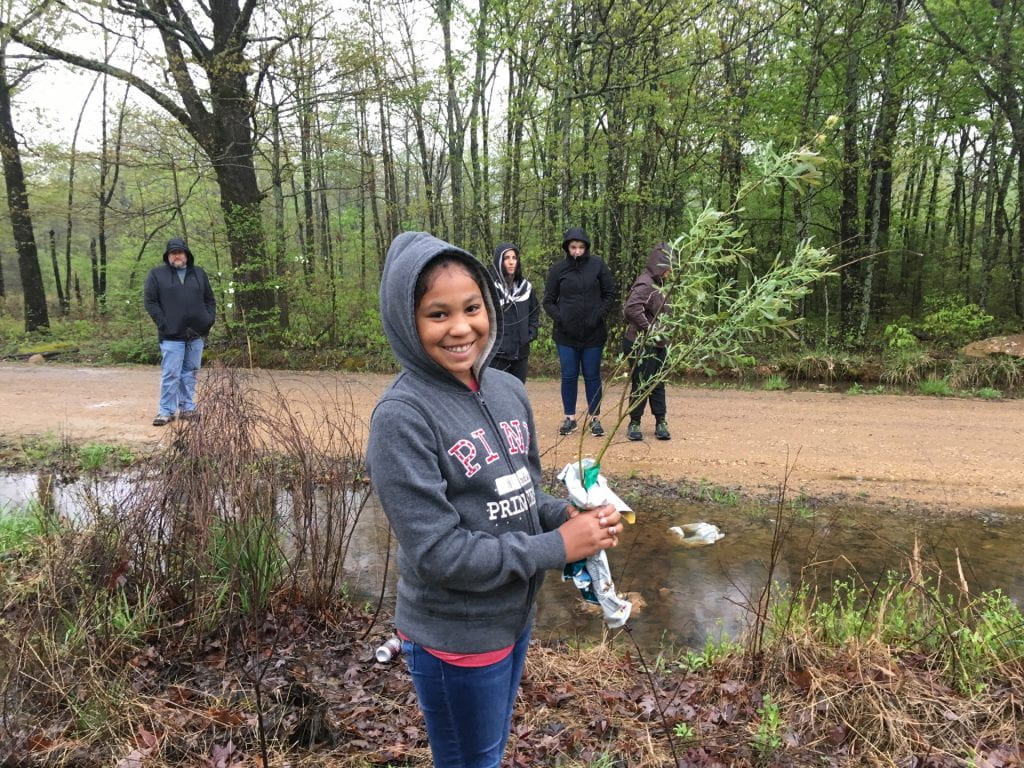
Junior member Cherokee Davis holds the cutting to transplant.
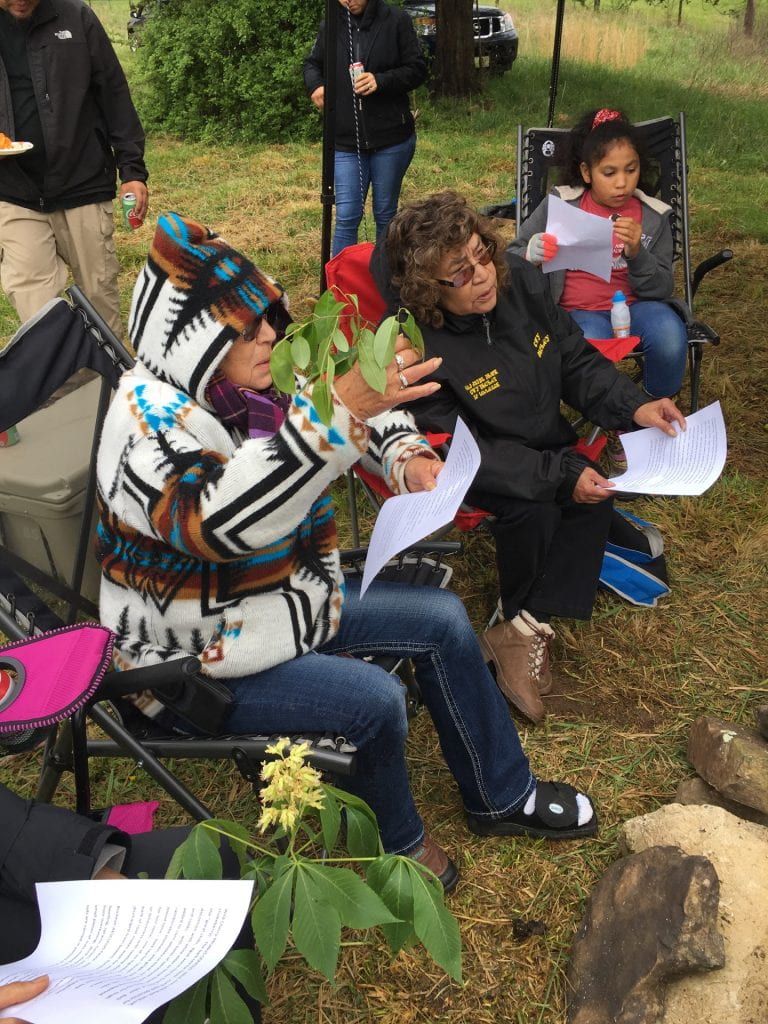
Medicine Keeper Bonnie Kirk discusses Wild Cherry (ᎩᏔᏯ).
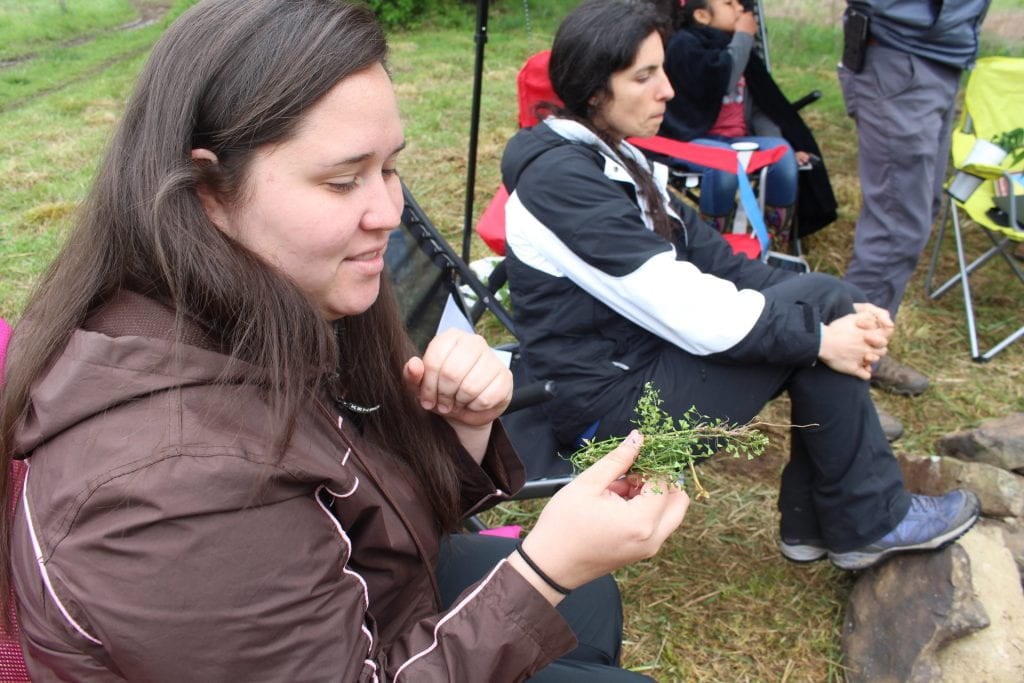
Student Kakiley Workman holds a Chickweed plant (ᏥᏔᎦᏂᏓ).
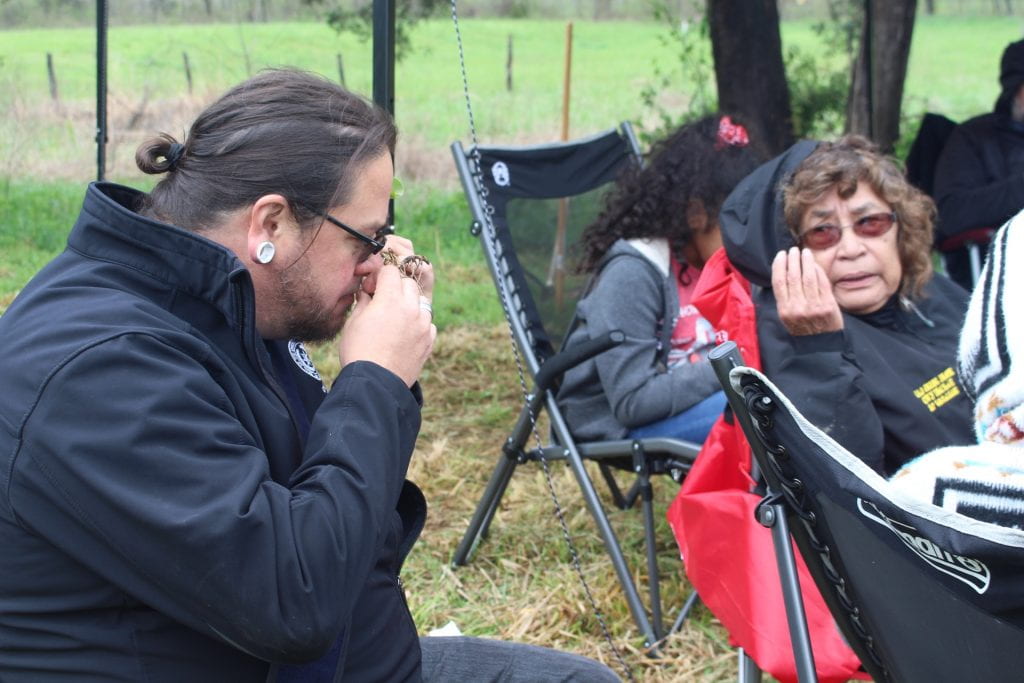
Medicine Keepers Ryan Mackey and Phyllis Edwards discuss a Calamus plant (ᏬᏱ ᎦᏙᎦ).
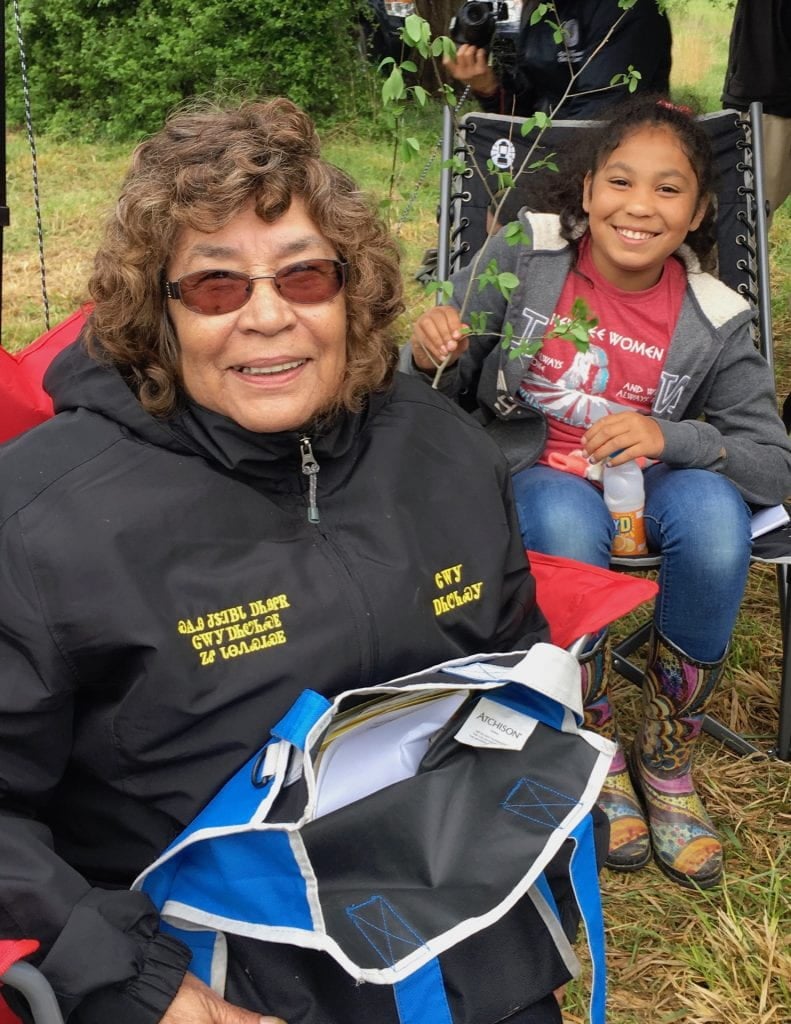
Medicine Keeper Phyllis Edwards and junior member Cherokee Davis. Cherokee is holding a Spicebush plant (ᏃᏓᏟ).
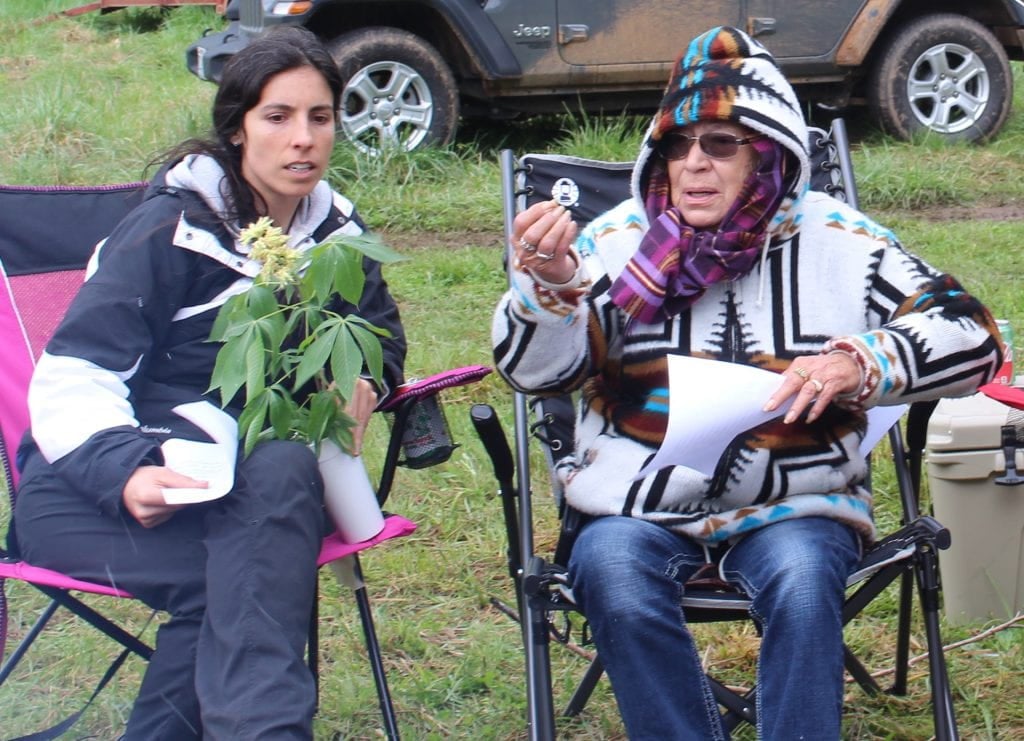
Student Summer Wilkie and Medicine Keeper Bonnie Kirk discuss a Buckeye plant (ᎤᏍᏆᏓ).
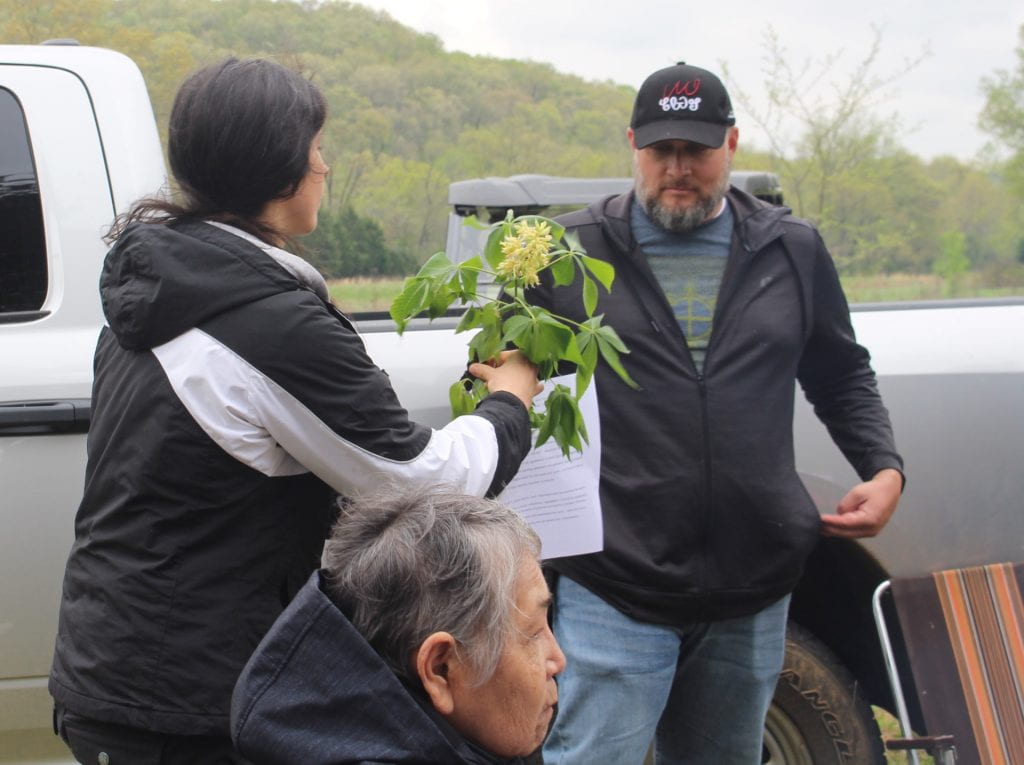
Students Summer Wilkie and Larry Carney examine a Buckeye plant.
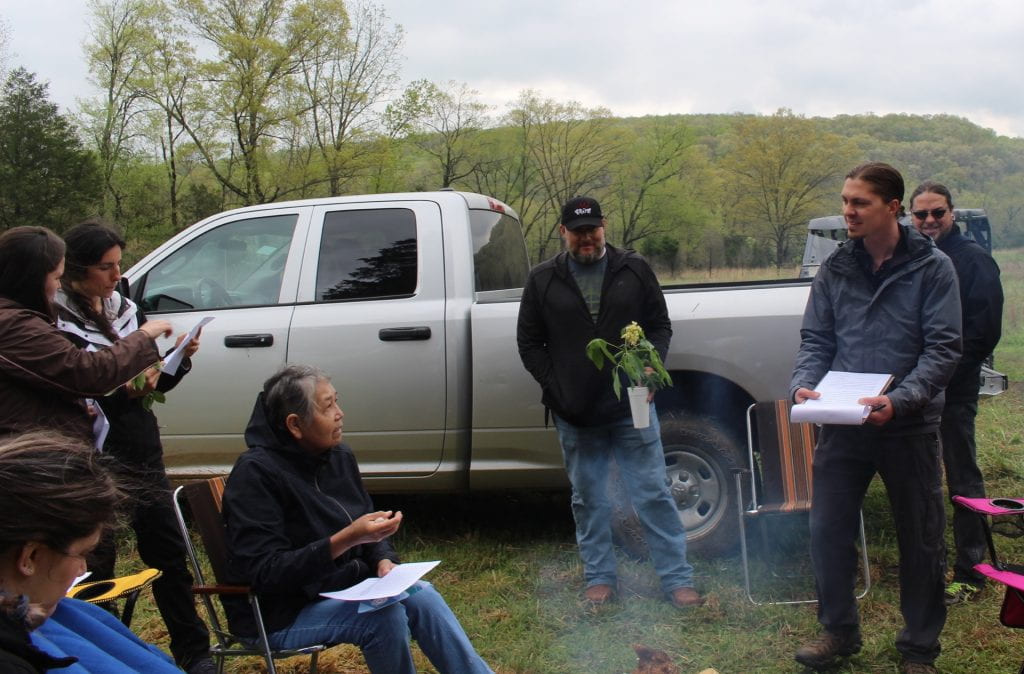
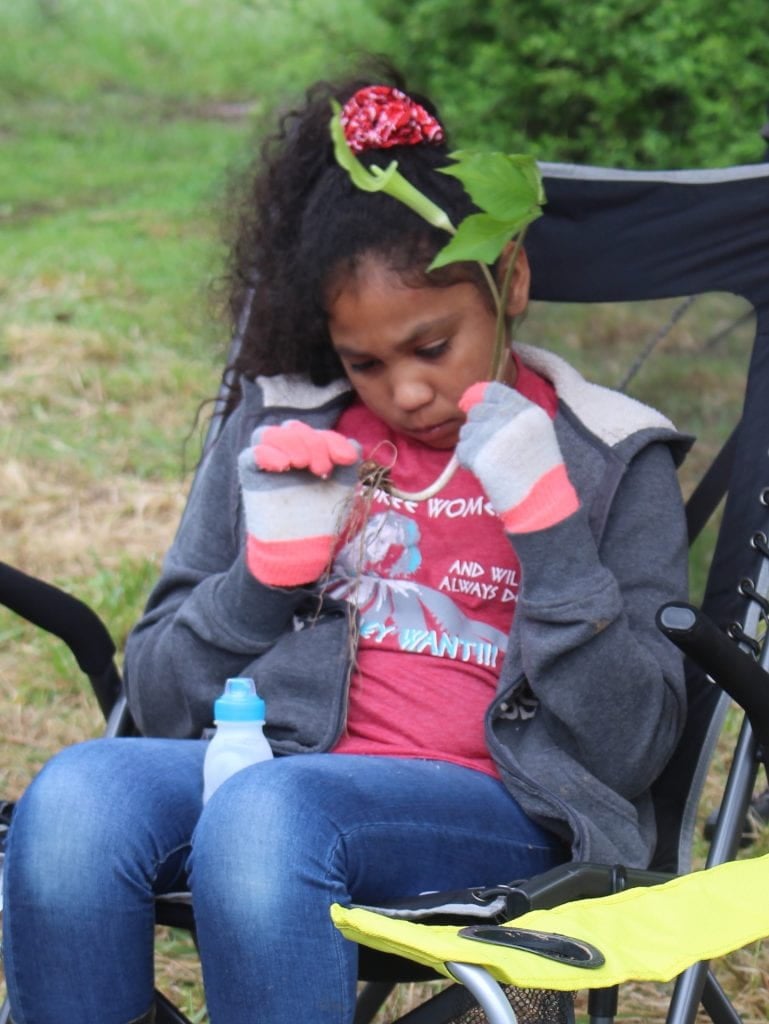
Cherokee Davis inspects a Jack-in-the-Pulpit plant (ᏢᏓᏥ ᎦᏙᎦ).
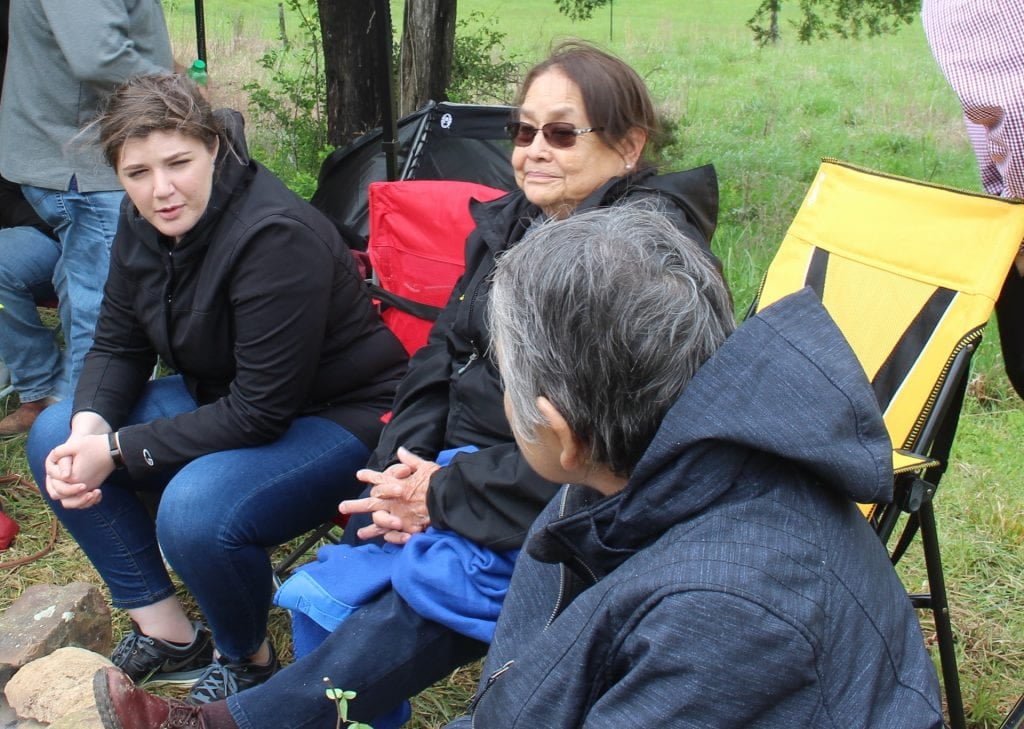
Student Savannah Anderson talks with Medicine Keepers Anna Sixkiller and Margaret Christie Leuthje.
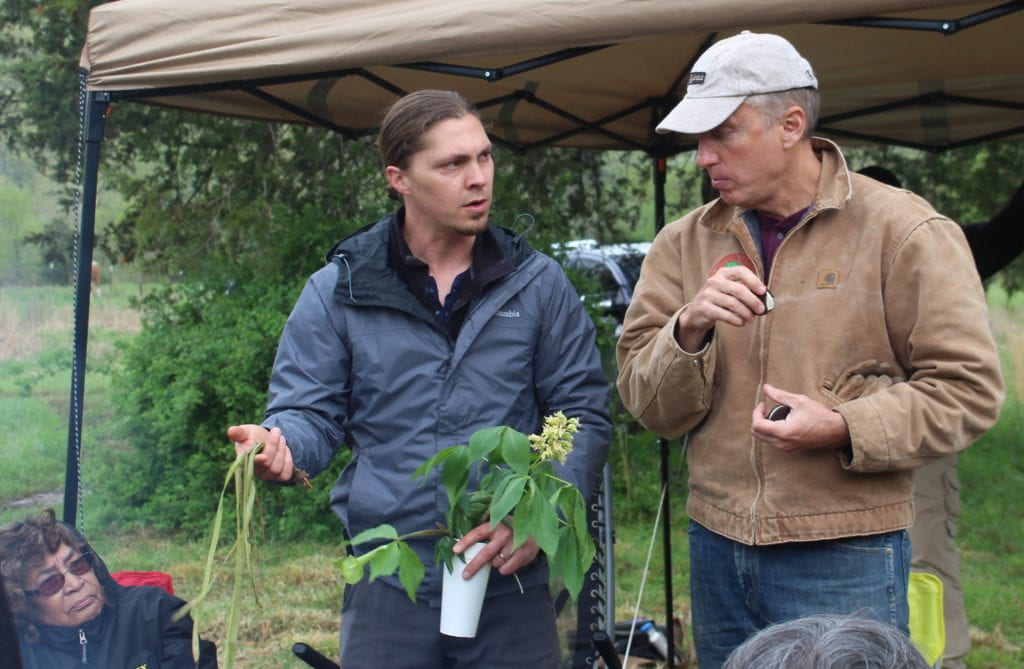
Clint Carroll and Pat Gwin discuss plants collected at the site.
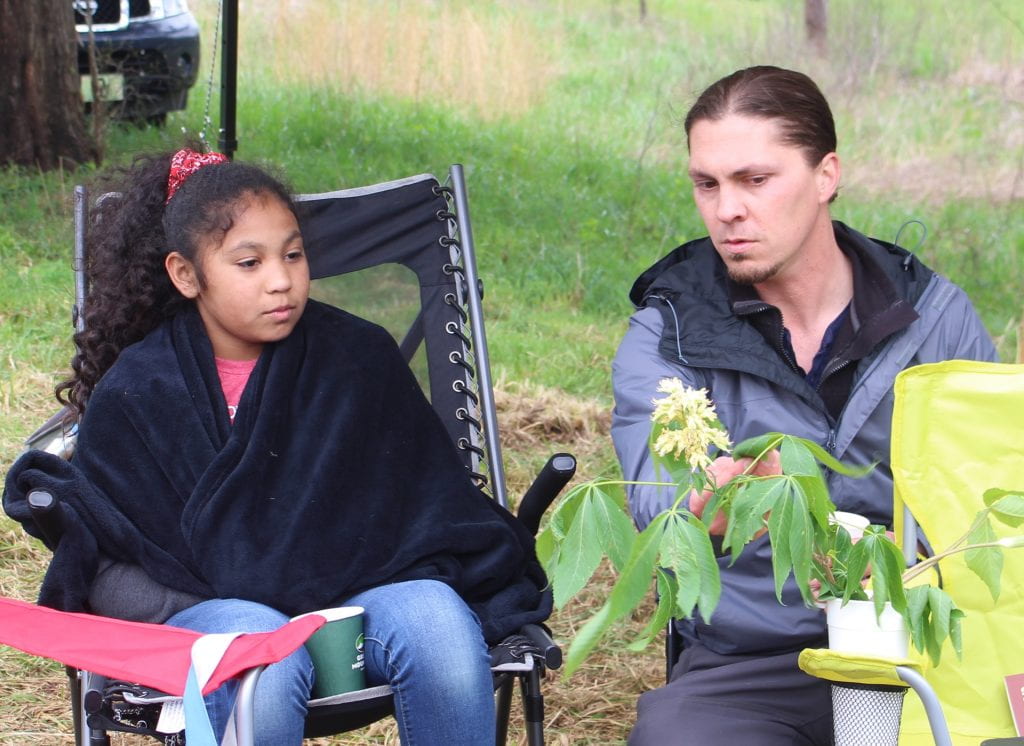
Clint Carroll and Cherokee Davis examine a Buckeye plant.
ᏎᎷ ᏙᎦᏠᏍᎬ ᏙᎦᏃᎮᏗ
On Friday, September 28, we gathered at the tribal complex in Tahlequah, OK to discuss the significance of corn—selu—to Cherokee people. The Medicine Keepers opened the meeting by telling stories about their childhood, when their parents and grandparents raised corn fields to feed their families. More than just a “staple food,” selu has sustained Cherokee people since time immemorial. The elders shared numerous traditional recipes, which we put into action with our heirloom corn from the Cherokee Nation Seedbank Program. Using a hand-cranked grain mill, the students ground Cherokee colored flour corn into meal. The Medicine Keepers showed students how to cook corn bread and numerous other traditional foods from scratch. Needless to say, we all had a great time learning, cooking, and eating!
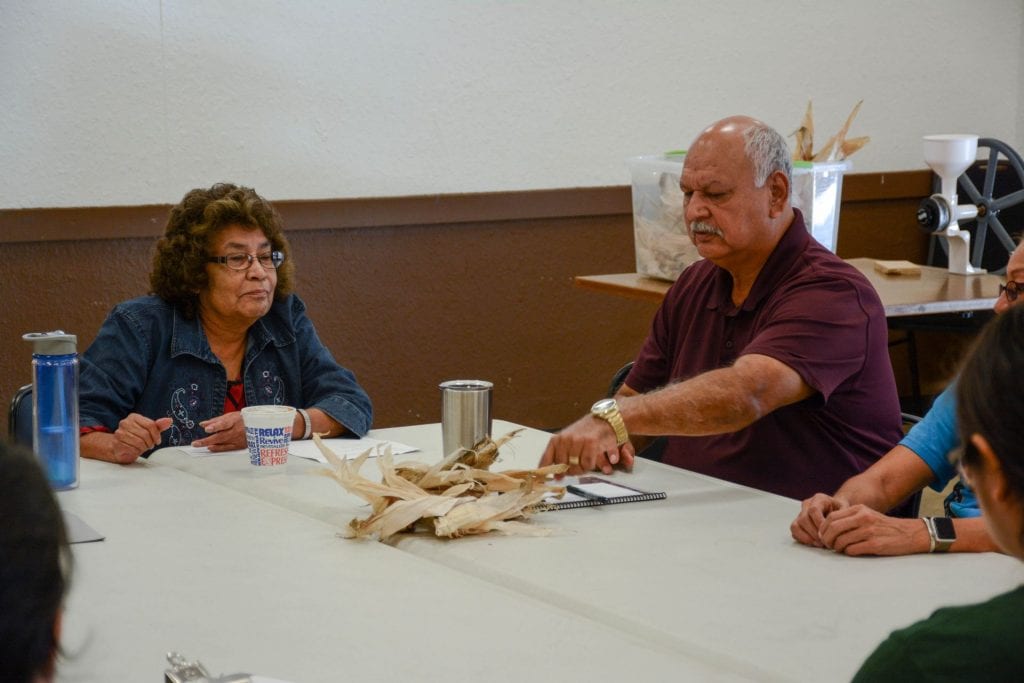
Medicine Keepers John Ross and Phyllis Edwards discuss the importance of corn to Cherokees. Photo by Stephanie Remer, Cherokee Nation Communications Department.

Pat Gwin describes the genetics of Cherokee heirloom corn. Photo by Stephanie Remer, Cherokee Nation Communications Department.

CELP students shelling Cherokee heirloom corn. Photo by Stephanie Remer, Cherokee Nation Communications Department.
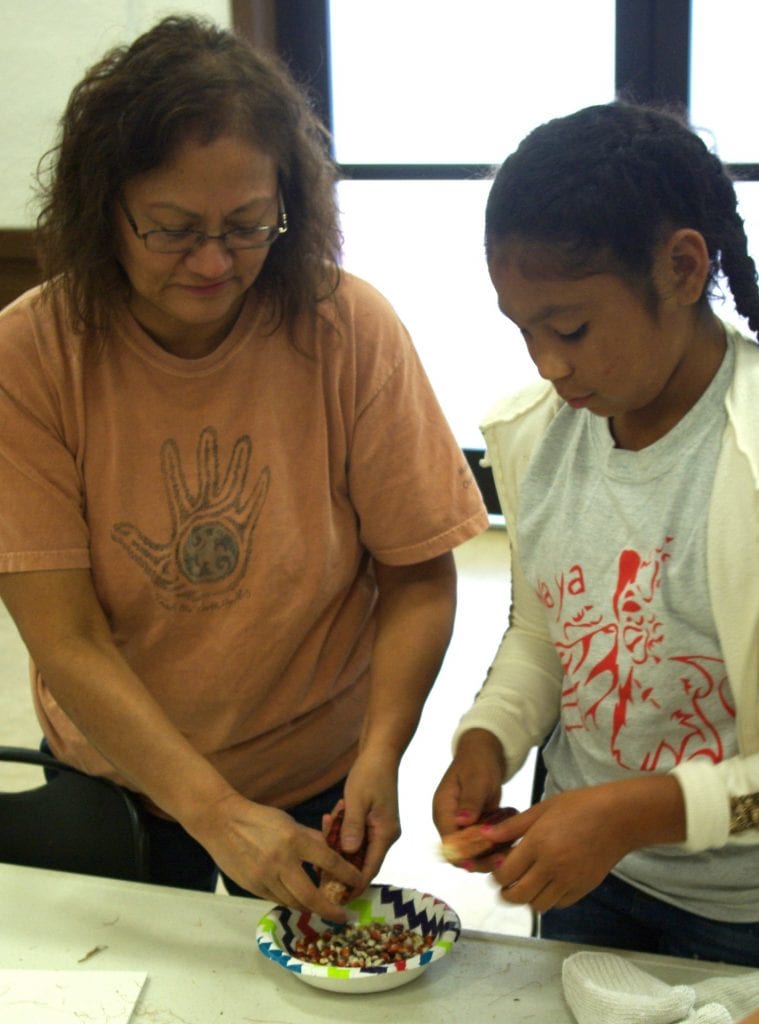
Medicine Keeper Nancy Scott shells corn with CELP junior member Cherokee Davis.
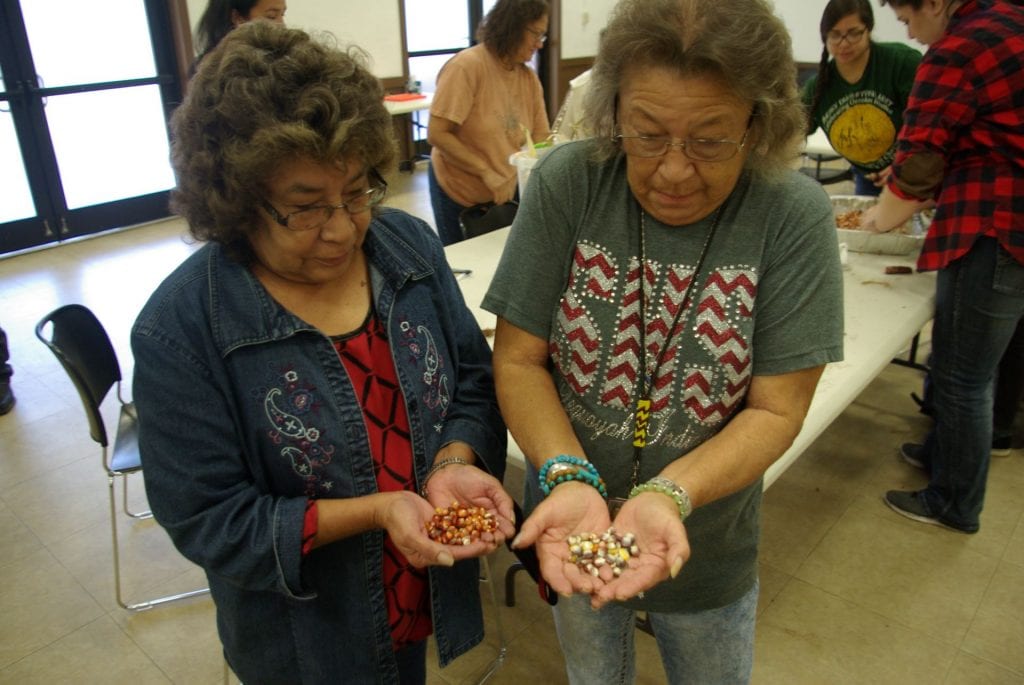
Phyllis Edwards and Bonnie Kirk with Cherokee heirloom corn.
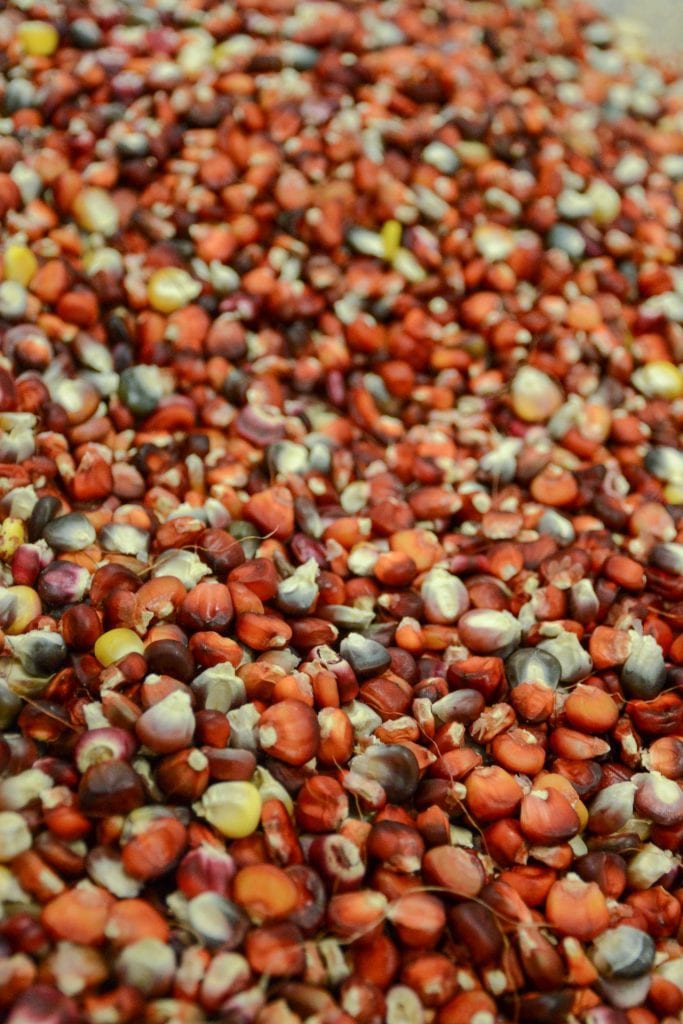
Heirloom Cherokee colored flour corn. Photo by Stephanie Remer, Cherokee Nation Communications Department.
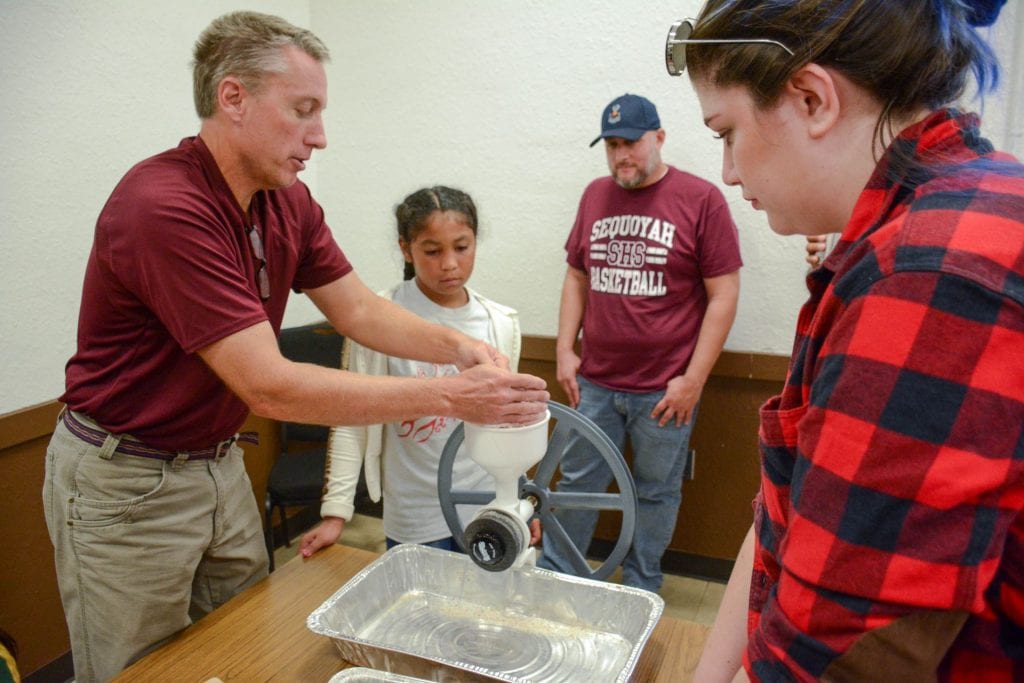
Pat Gwin instructs students on how to operate the grain mill. Photo by Stephanie Remer, Cherokee Nation Communications Department.
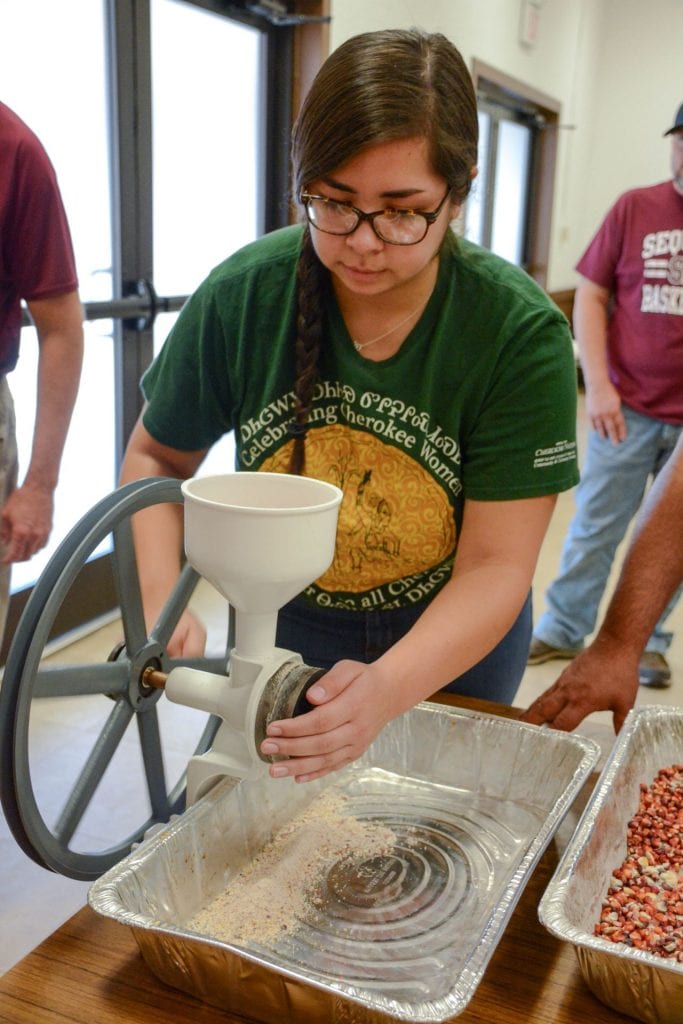
CELP student Sky Wildcat. Photo by Stephanie Remer, Cherokee Nation Communications Department.
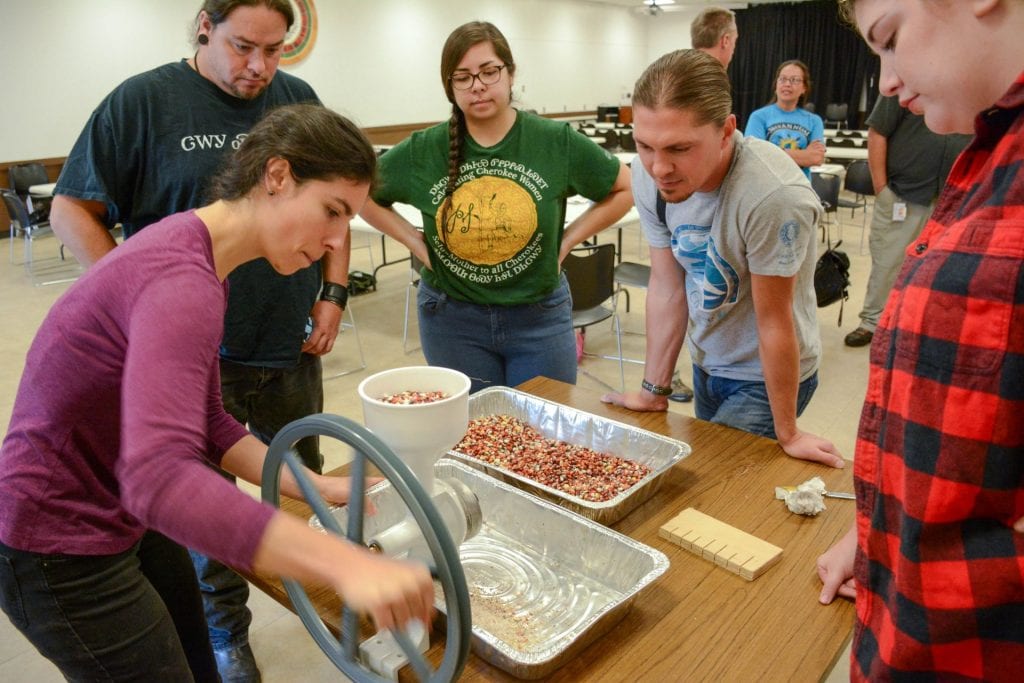
Photo by Stephanie Remer, Cherokee Nation Communications Department.
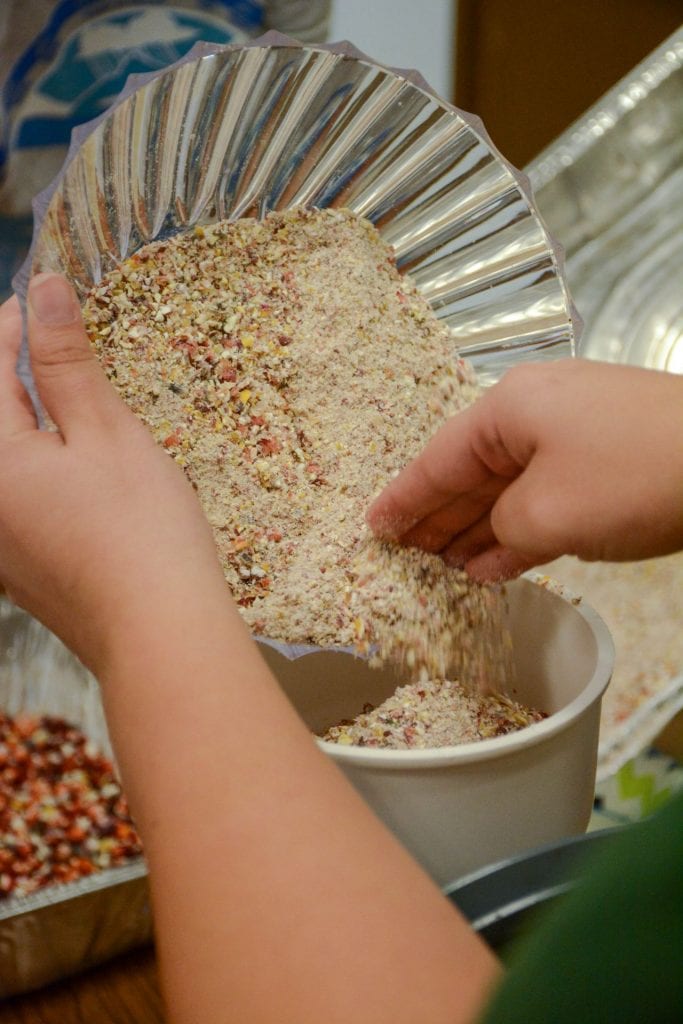
Photo by Stephanie Remer, Cherokee Nation Communications Department.
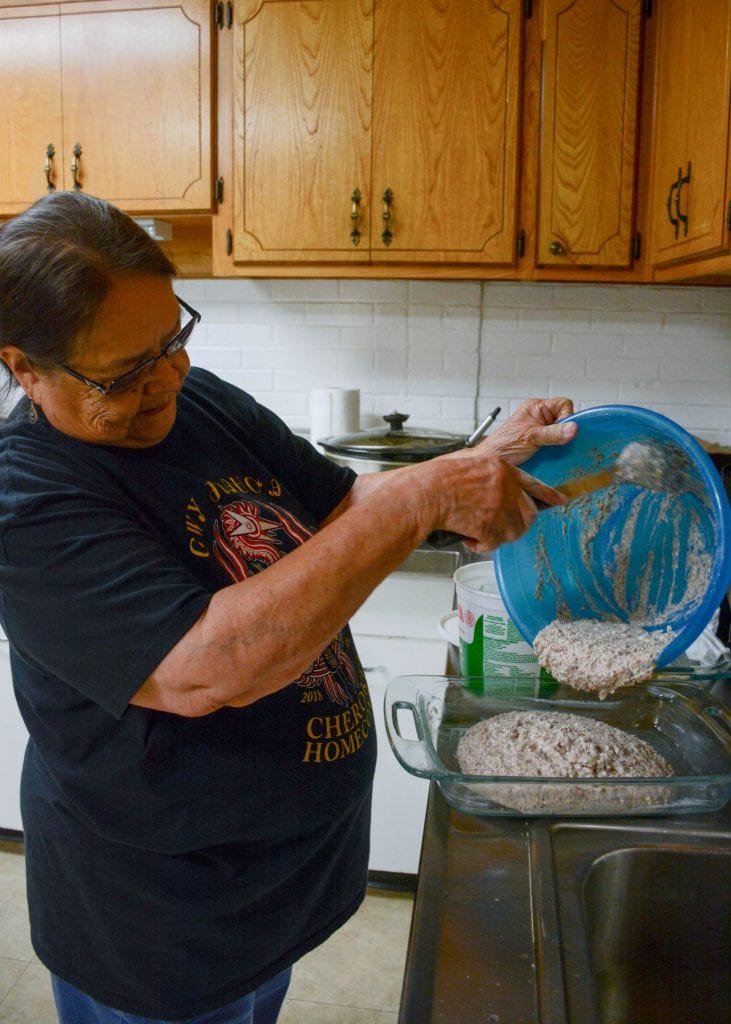
Medicine Keeper Anna Sixkiller making corn bread. Photo by Stephanie Remer, Cherokee Nation Communications Department.
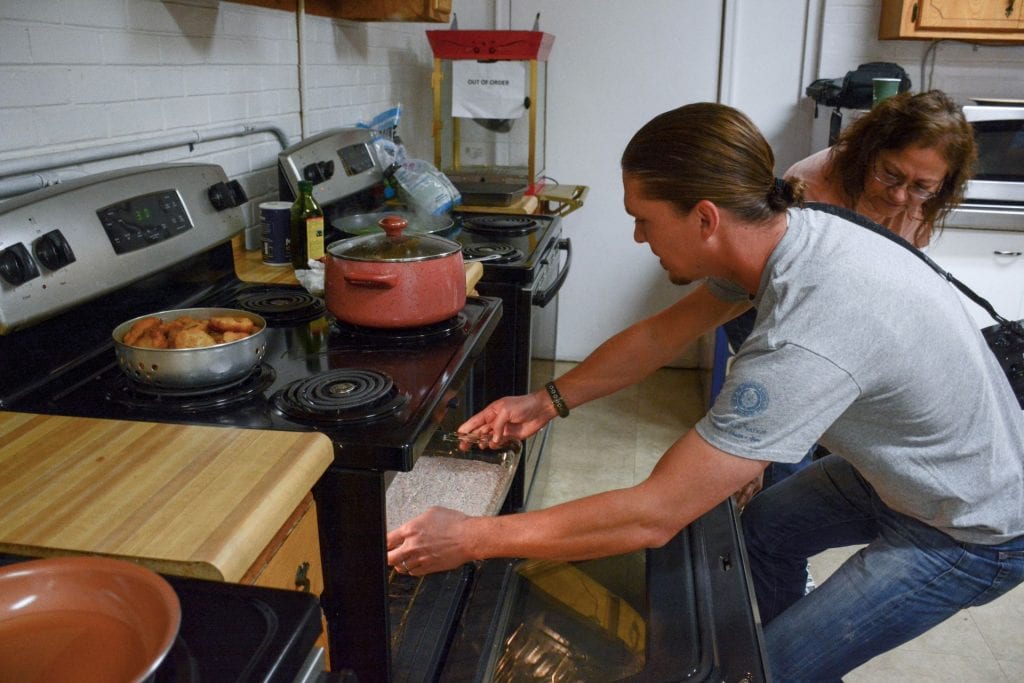
Photo by Stephanie Remer, Cherokee Nation Communications Department.
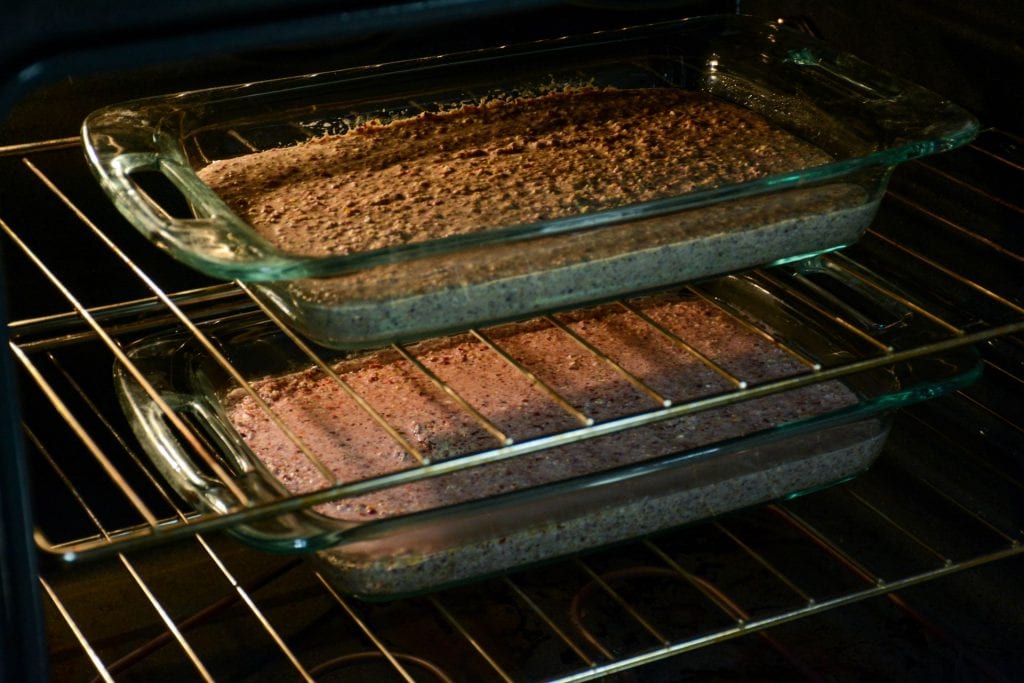
Photo by Stephanie Remer, Cherokee Nation Communications Department.
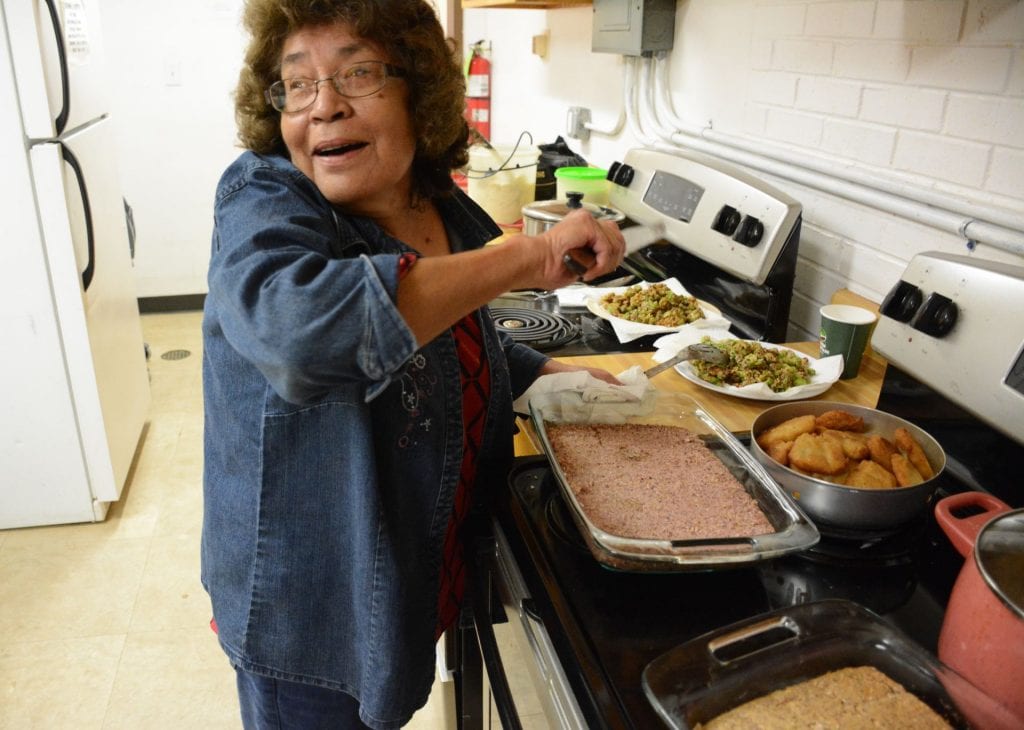
Medicine Keeper Phyllis Edwards with fresh corn bread. Photo by Stephanie Remer, Cherokee Nation Communications Department.
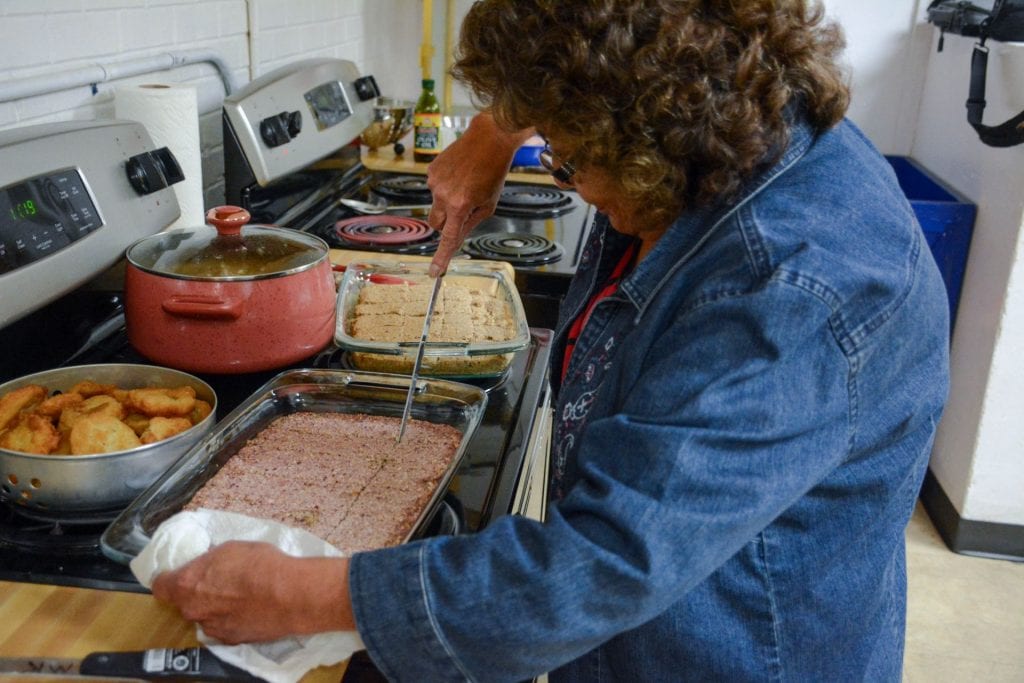
Photo by Stephanie Remer, Cherokee Nation Communications Department.
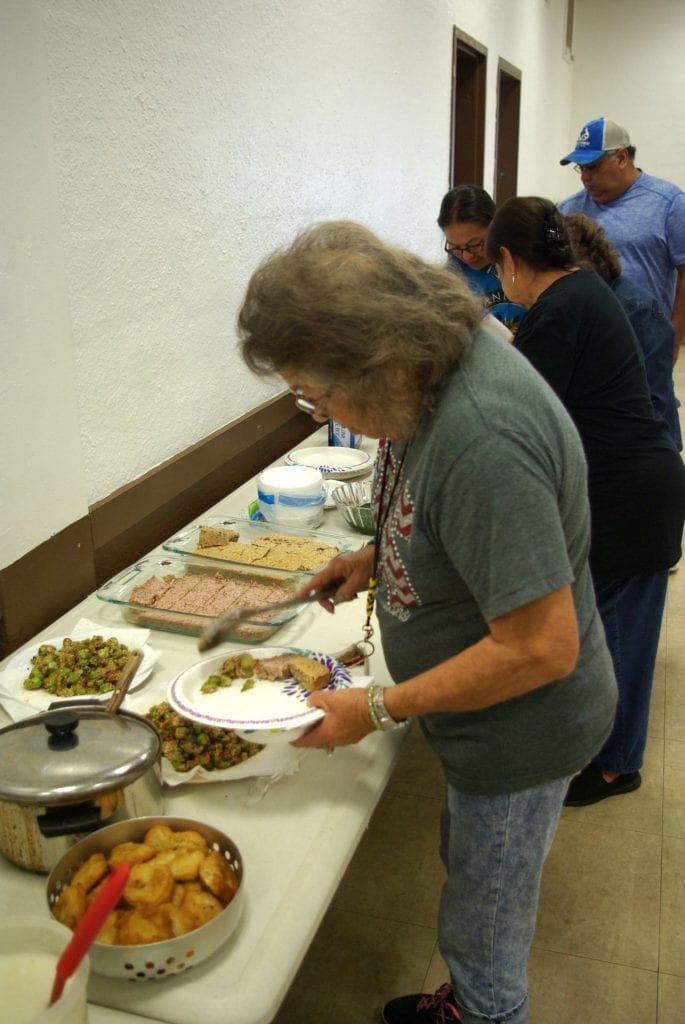
ᎢᏓᎵᏍᏓᏴᎲᎦ! Let’s eat!
On July 26-27, we welcomed our student cohort (Savannah Anderson, Larry Carney, Sky Wildcat, Summer Wilkie, and Kakiley Workman) and kicked off the land education program. Students toured the Cherokee Nation Heirloom and Native Plants Garden, visited with elder and spiritual leader Crosslin Smith at his home, and generally got to know their Medicine Keeper mentors. We closed the kickoff meeting on Friday with an ethnobotany hike led by Senior Director of Environmental Resources, Pat Gwin, on a remote and beautiful tract of tribal land in Adair County. We were grateful for good weather and no encounters with any poisonous snakes! We all look forward to the next three years of learning and working together to further the goals of the Medicine Keepers.
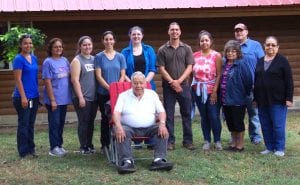
The group gathered at Crosslin Smith’s home for a traditional blessing. L to R: Feather Smith-Trevino, Nancy Scott, Kakiley Workman, Summer Wilkie, Savannah Anderson, Clint Carroll, Sky Wildcat, Phyllis Edwards, Larry Carney, Anna Sixkiller. Seated: Crosslin Smith.
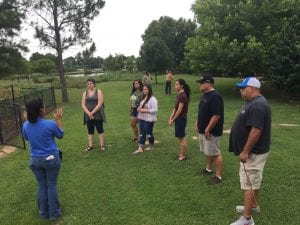
Feather Smith-Trevino gives a tour of the Cherokee Nation gardens. L to R: Feather Smith, Savannah Anderson, Sky Wildcat, Kakiley Workman, Summer Wilkie, Larry Carney, Gary Vann. Background: Kevin Daugherty, Pat Gwin.
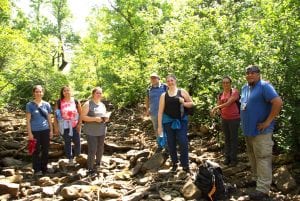
Students and staff on the ethnobotany hike in Adair County. L to R: Summer Wilkie, Sky Wildcat, Kakiley Workman, Larry Carney, Savannah Anderson, Nancy Rackliff, Kevin Daugherty.
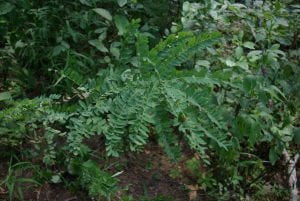
ᎧᎶᏪᏗ ᎤᏍᏗ / False indigo bush (Amorpha fruticosa), a Cherokee medicine plant. Photographed on the ethnobotany hike.
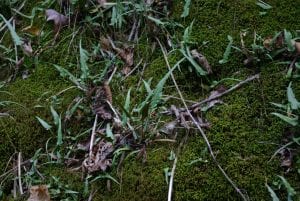
ᎢᎾᏓ ᎦᏅᎪᎢ / Walking fern (Asplenium rhizophyllum), a Cherokee medicine plant. Photographed on the ethnobotany hike.
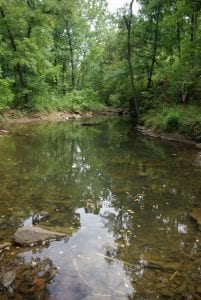
ᎠᎹ ᎤᎵᏍᎨᏗᏳ.
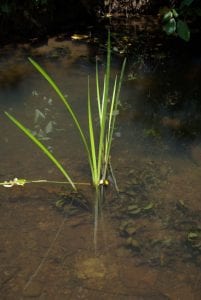
ᏬᏱ ᎦᏙᎦ / Sweet flag (Acorus calamus), a Cherokee medicine plant. Photographed on the ethnobotany hike.
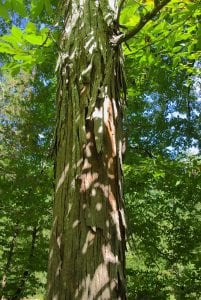
ᏩᏁᎢ / Shagbark hickory (Carya ovata), a culturally significant Cherokee tree. Photographed on the ethnobotany hike.
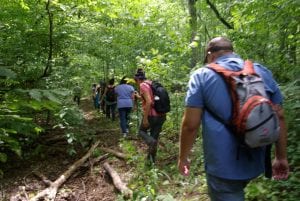
Students and staff on the ethnobotany hike.
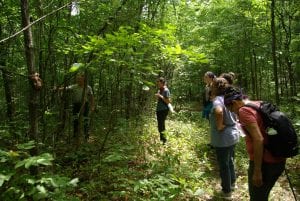
Pat Gwin discusses culturally significant plants with the student cohort on the ethnobotany hike.
Itsvyalihelitseha (we are grateful to you all). Thanks to all those who applied to the land education program, and to the finalists who participated in the interview sessions on April 18-20. I was grateful to be able to meet such an inspiring group of Cherokees! We received 20 applications in total, and we interviewed 10 finalists, from which we will select 5 students to make up the program cohort. No doubt, this will be a difficult task. Nevertheless, we look forward to planning the kickoff meeting this summer.
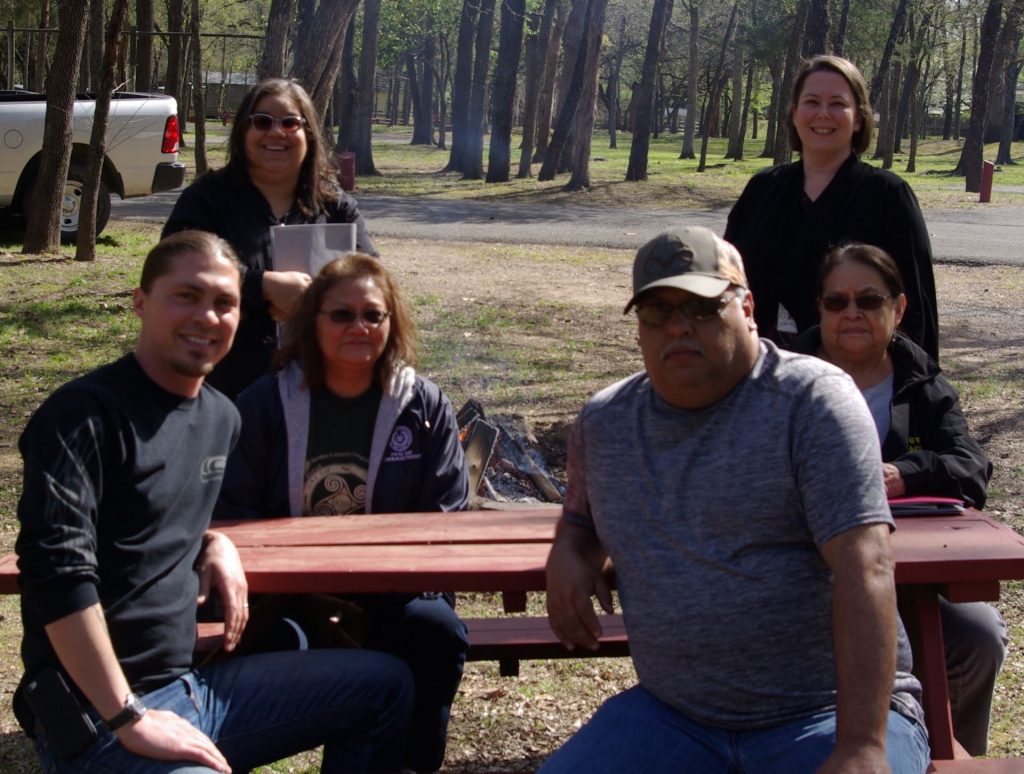
L to R: Clint Carroll, Dawni Saloli, Nancy Scott, Gary Vann, Secretary of Natural Resources Sara Hill, Anna Sixkiller. Not pictured (but present for all or part of the interview sessions): Kevin Daugherty, Phyllis Edwards, Ed Fields, Pat Gwin, Bonnie Kirk, Ryan Mackey, Nancy Rackliffe, Feather Smith-Trevino
We’re excited to announce the Call for Applications for the Cherokee Environmental Leadership Program.
The Cherokee Environmental Leadership Program is a three-year land-based education program that seeks to train Cherokee young adults in traditional ecological knowledge, the Cherokee language, Western scientific knowledge, and social science research methods to address natural resource issues in northeastern Oklahoma. The program is funded by the National Science Foundation, and is directed through a partnership between the Cherokee Nation Medicine Keepers (an incorporated group of respected Cherokee elders), the Cherokee Nation Office of the Secretary of Natural Resources, and Dr. Clint Carroll—a University of Colorado professor and Cherokee Nation citizen. We are seeking dedicated individuals who are committed to learning and perpetuating Cherokee culture. Applicants must also have a vested interest in addressing local environmental issues in Oklahoma.
Five selected students will receive training in local environmental knowledge, drawing from traditional Cherokee and Western scientific sources. Students will also study the Cherokee language, learn about critical issues in tribal environmental policy, and receive research experience working on a social scientific research project in the Cherokee Nation.
Eligibility: Cherokee Nation, United Keetoowah Band, or Eastern Band citizenship; residence in northeastern Oklahoma or the immediately surrounding area.
Qualifications: A strong commitment to learning and perpetuating Cherokee lifeways, language, and knowledge, as demonstrated through the written application and an in-person interview (if selected).
Time Commitment: Over the course of the three-year program (June 2018-May 2022), students will be expected to commit an average of 10 hours per week to the project.
Applications are due Friday, March 16, 2018.
To apply, visit https://knowingtheland.edublogs.org/apply/
See also the Press Release in the Cherokee Phoenix.
I recently sat down with Dr. Lisa Schwartz of the CU Boulder Office of Outreach and Engagement to discuss my work in Oklahoma and how this project developed. You can read it at the Engagement Scholarship Series site.